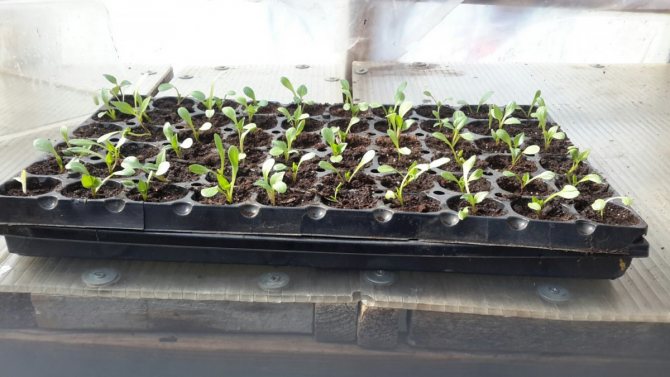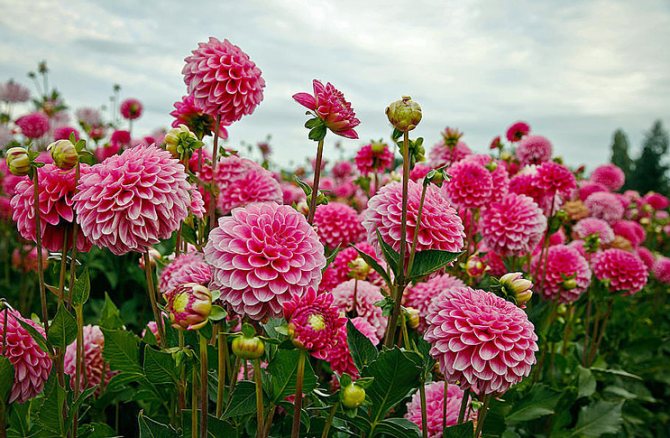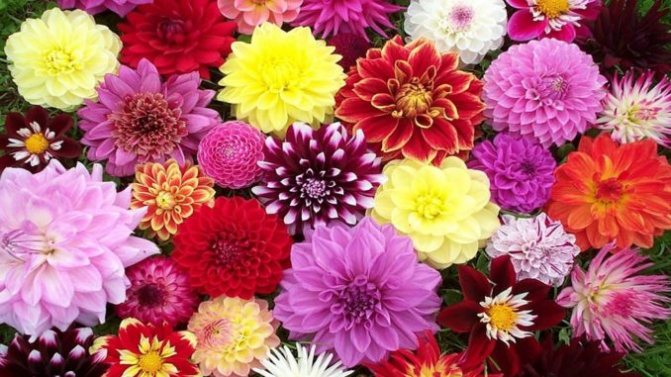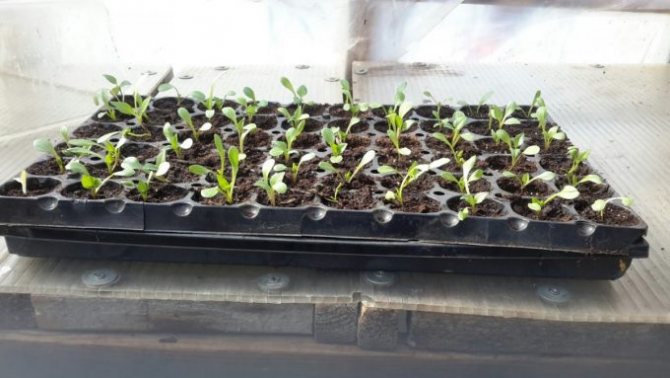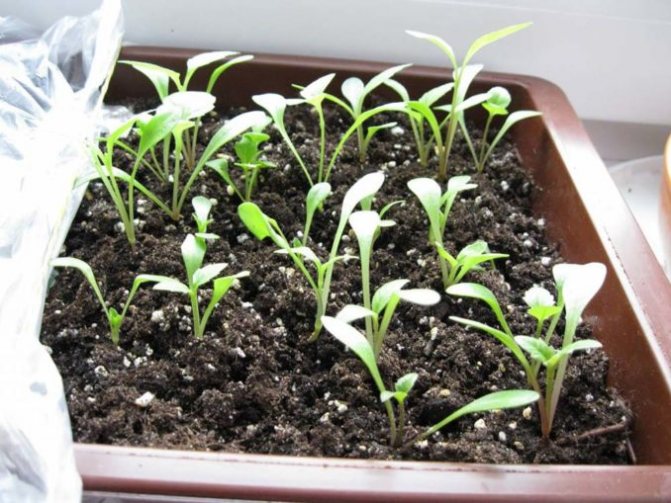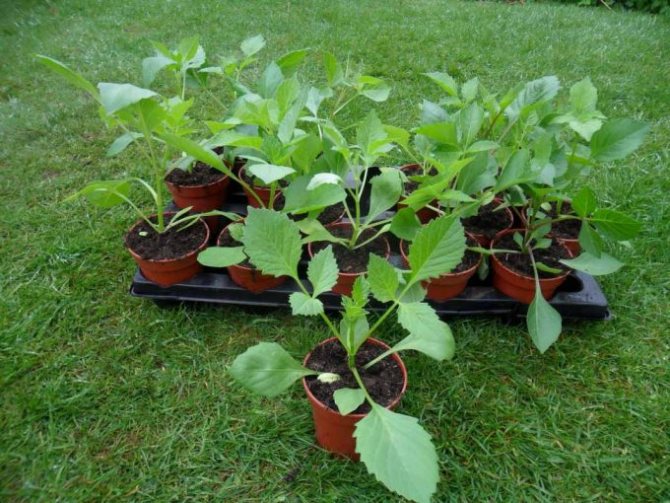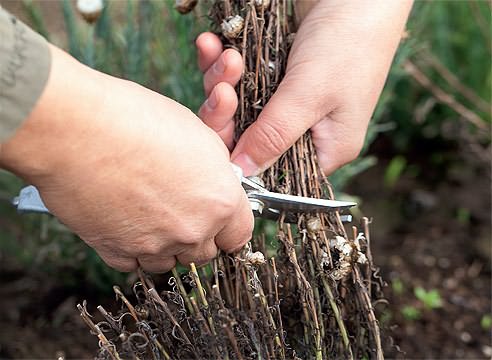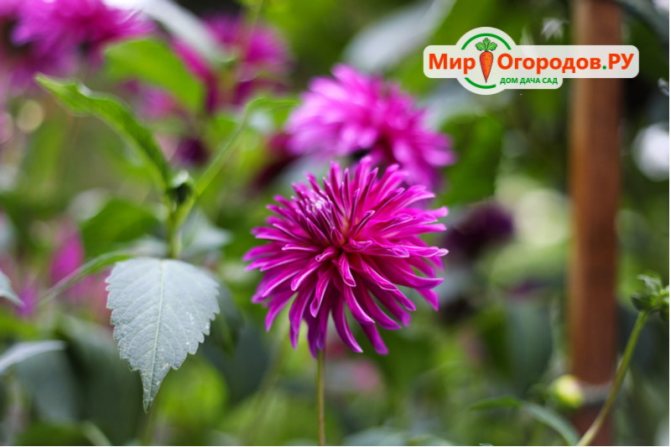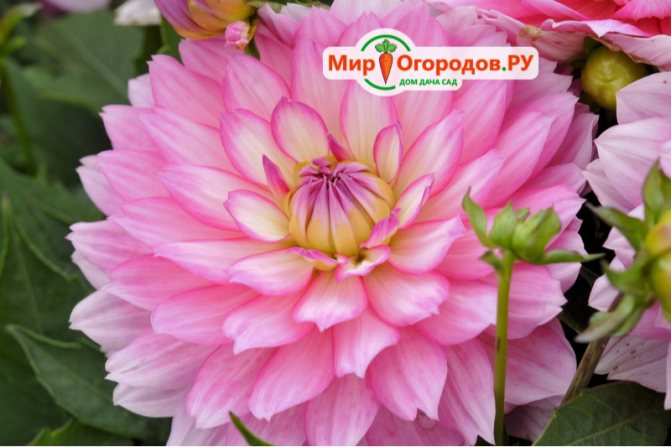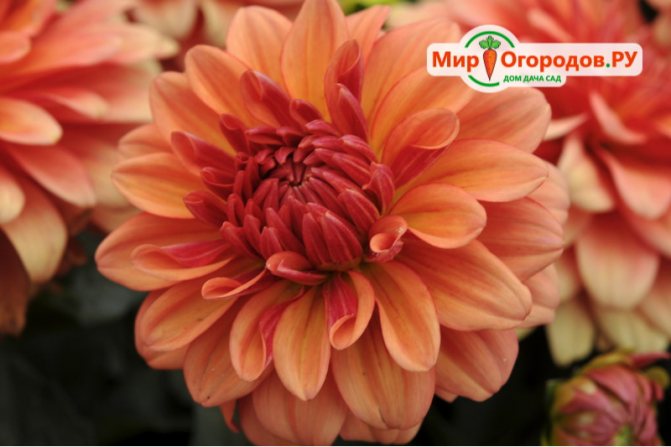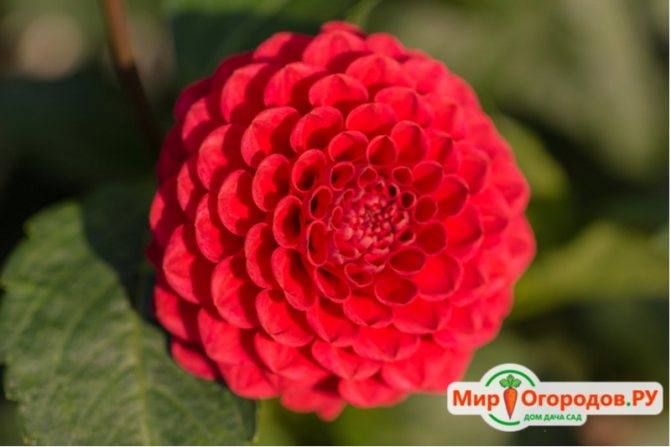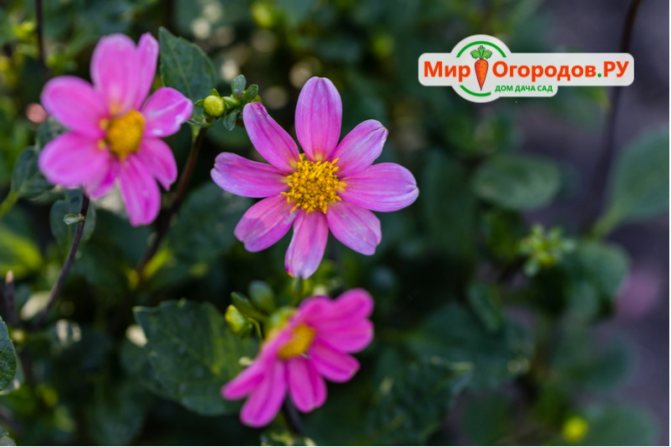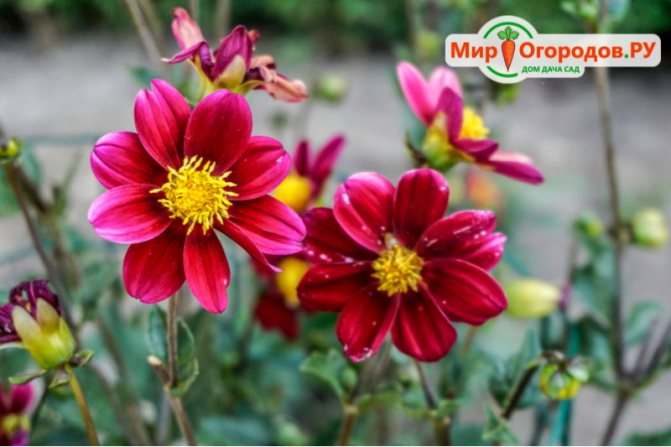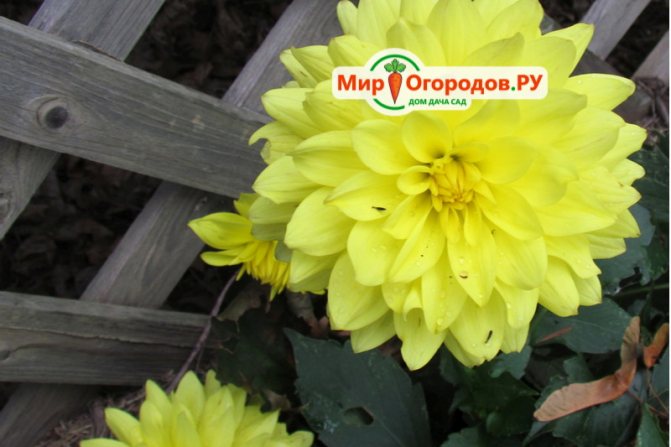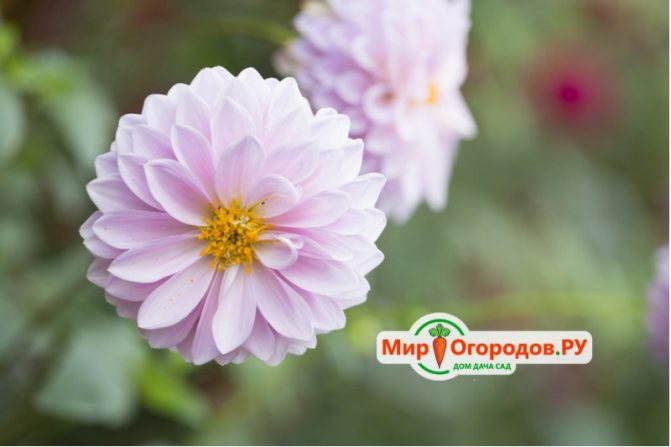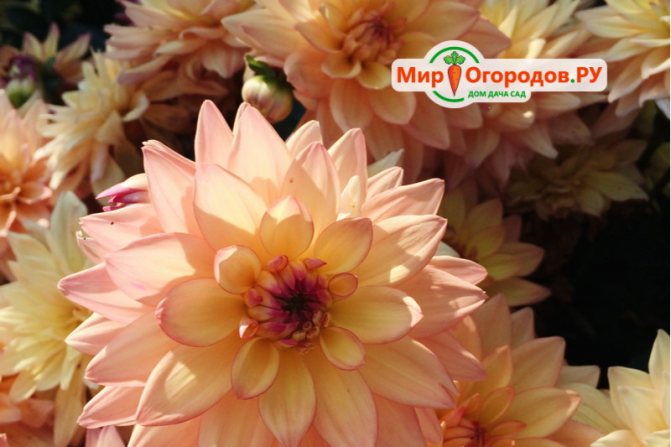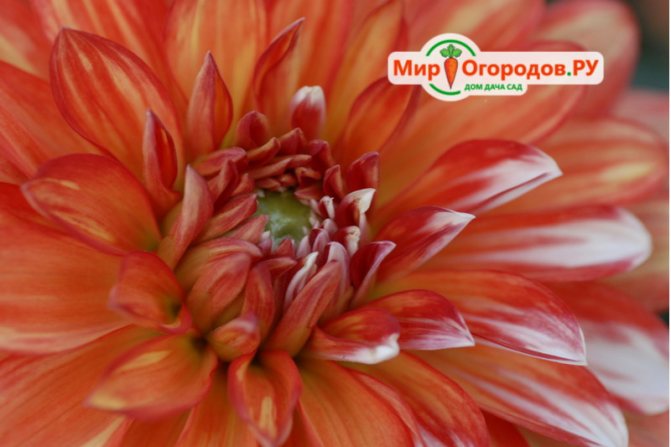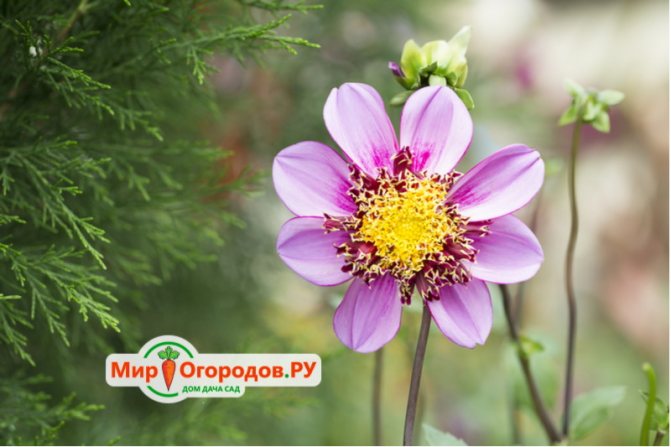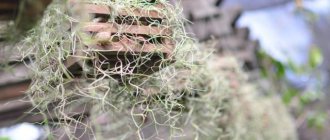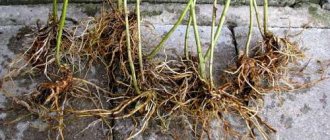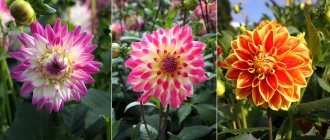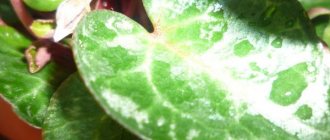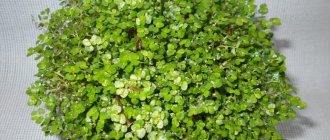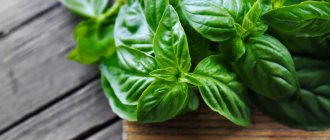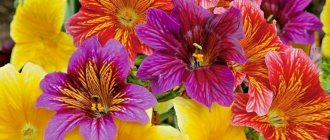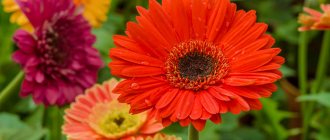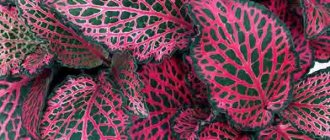Annual dahlias are beautiful, bright flowers. They belong to the Aster family. They have two official names. First, in 1791, the flower was named "Dahlia" in honor of A. Dahl, a Swedish botanist, a student of K. Linnaeus. But then it turned out that a shrub already had such a name, and the flower was renamed "Dahlia" in honor of Johann Georgi, professor of the St. Petersburg Academy of Sciences.
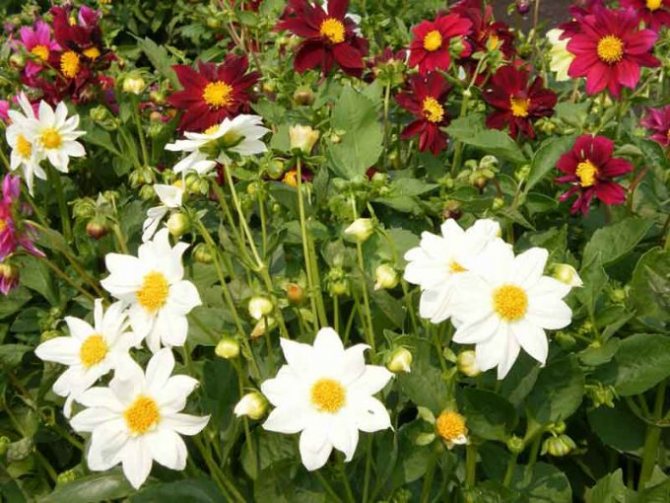
Annual dahlias. Planting and care: a little bit of valuable information for novice florists
Among the representatives of the Astrov family, after the asters themselves, the most considerable attention of gardeners, perhaps, is lured by annual dahlias. Planting and caring for these plants, not paying attention to their seeming capricious aristocratic nature, will not require much work even from novice flower growers, but all summer and autumn, right up to the first cold weather, dahlias will delight everyone with a riot of colors of their own chic terry, semi-double and non-double inflorescences.
Annual dahlias: getting to know each other and getting ready for planting
In fact, this variety of dahlias is considered perennial, only grown as an annual. The bushes grow up to 80 cm in height, the inflorescences are up to 12 cm in diameter, a wide variety of flowers and flower shapes, the ability to please the eyes at once with a high number of blossoming buds (up to 15 flowers on one plant) - all these are annual dahlias. Planting and caring for them begins with the purchase of seeds. Nowadays, in flower shops you can find seeds of very different varieties of annual dahlias, sometimes even wide eyes. Basically, the ideal option if you cannot form with the choice of a particular variety and color is to purchase a mixture of seeds of different hybrids.
Preparing the soil and sowing seeds
In most cases, sowing of seeds of annual dahlias is done in the last days of April. Fertile soil is harvested since autumn. Specifically, before planting, it is recommended that the soil be calcined and treated with a weak solution of potassium permanganate for disinfection purposes. The seeds of annual dahlias are very large, so it is not difficult to sow them: spread them on the surface of the soil, sprinkle them with sand and lightly compact, and then water them. Put the greenhouse in a warm place where there are no drafts, and wait for the hour when annual dahlias sprout. Caring for seedlings will not require much work from you. With the appearance of 2 real leaves, the plants are transplanted (best of all, each in a separate container), and closer to June, when it becomes very warm, the seedlings are formed in a permanent place - a sunny area with loose soil with black soil. Plants are planted at a distance of 30-40 cm.
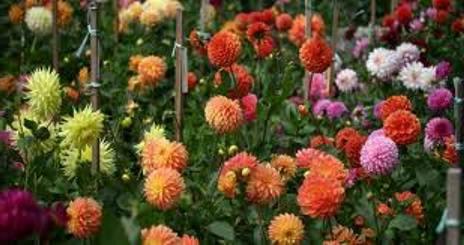

Annual dahlias are drought-resistant plants in the garden, thanks to this they prefer calm watering: during the period of vigorous growth, once a week is enough. On especially hot days, dahlias will not refuse a cool shower. From the end of August, when the heat drops, watering is slightly reduced.
We are waiting for flowering and enjoying the explosion of bright colors in our own summer cottage
Annual dahlias, planting and caring for which in your flowerbed begin with planting seedlings in open ground, will bloom much until recently - in about one and a half to two months, in other words, by planting seedlings in the last days of May, you can see the first blossoming buds already in July. At the same time, undersized hybrids bloom much until recently their own tall counterparts. Actually, because of this reason, dwarf non-double varieties of annual dahlias, which are also called border dahlias, are very popular when decorating flower beds and areas with ornamental plants.Annual dahlias are very well able to solo in a group planting. The photos show how amazingly attractive such areas with ornamental plants are possible. This look in bouquets looks no less impressive and stands for a long time.
We collect seeds for the next season
In order to preserve in your own collection those annual dahlias, the planting and care of which are planned in future seasons, you can emphasize on the bush several of the strongest and most developed inflorescences. The seeds ripen in them within about one and a half months. But, remember always about the fact that the coloring of flowers in plants of the second generation differs from the parent ones. This trait is completely inherited only through tubers.
History and interesting facts
There is a beautiful legend regarding the origin of this flower. Millions of years ago, when the period of severe cold began on Earth, people struggled to keep warm, but the last fire eventually went out. A beautiful flower grew in its place, the petals of which resembled tongues of flame. He easily survived the ice age, and when sunlight returned to the planet, he began to multiply, and since then has symbolized the all-conquering vitality.


Dahlia annual
If we talk about scientific facts, then Central America (Peru, Chile, etc.), as well as the southern regions of the North, are considered the birthplace of dahlias. These flowers have been known to man since the time of the Aztecs and Mayans - the plants that the Indians grew up to six meters in height, so their stems were used as water pipes. Another useful property of dahlias, which the aborigines knew well, is that their tubers can be eaten (although this applies only to wild plants growing in warm regions).
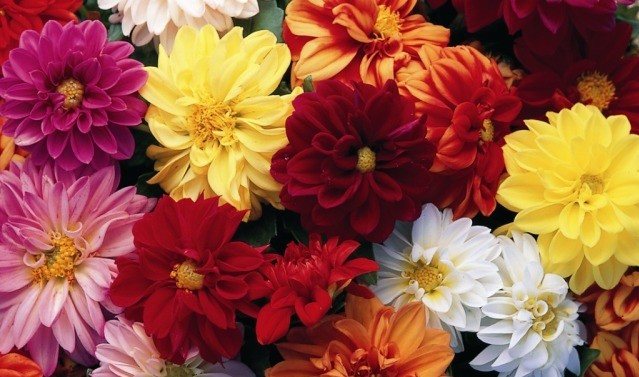

Dahlia annual terry
Dahlia seeds came to Europe in the 18th century - they were brought to Madrid as a vegetable crop. However, the taste of the tubers did not impress the inhabitants of the Old World, but the beauty of the flowers won the heart of the Spanish king. Since that time, a real boom in the cultivation of this plant began. Its seeds were worth their weight in gold, and ordinary gardeners who grew a flower quickly became millionaires.
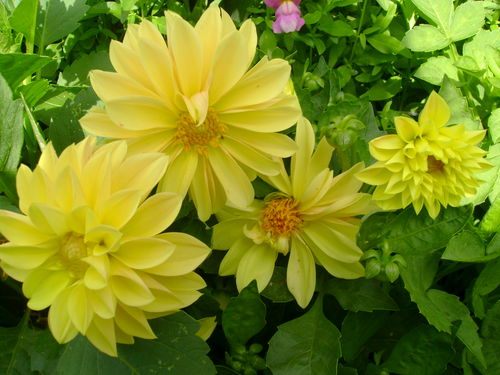

Geogin yellow
Varieties and types
Nowadays, there are many types of dahlias. Such a very large selection will give you the opportunity to find dahlias that will amaze even a very skillful and sophisticated florist with their own beauty.
Let's briefly talk about some of the most common types of dahlias grown in plots in the country and in gardens:
- collared dahlias - stand out with petals of different sizes: in the middle - short and rolled into "tubes", and the outer edge of the inflorescence is framed by flat and long petals;
Collar
- anemone dahlias are somewhat reminiscent of collar dahlias. In the middle of the inflorescence there are short beautiful tubes, and along the edges there are flat wide petals;
Anemone
- nymph dahlias are very different from their counterparts. The inflorescences are flat, in the very center there is a convex fluffy middle of short tubular petals, and along the edges - a row of flat wide petals;
Nymphae
- needle dahlias are distinguished by thin petals of different lengths, twisted into a dense tube. A subspecies of these dahlias are semi-needle dahlias, the petals of which are more similar to beautiful cones, and not to needles;
Acicular
- spherical dahlias - differ from other representatives by rounded lush inflorescences. The petals are fleshy, large, slightly twisted into a tube and collected in a soft, loose inflorescence;
Spherical
- pompom dahlias - similar to spherical.They have similar lush round inflorescences of coiled petals, but somewhat small in size and denser to the touch;
Pompom
- peony dahlias - are distinguished by very lush inflorescences, each of which has several rows of wide oval petals, and in the middle there is a group of short ones twisted into beautiful tubes.
Peony
In addition, all varieties of dahlia varieties are divided into annual and perennial. Let's dwell on this division and the features of caring for these flowers in great detail.
Varieties
Dahlia varieties stand out
- By the height of the bush:
- High;
- Average;
- Dwarf.
- By type of inflorescence (size, shape, color of petals)
Popular: Varieties of rose scrub varieties with care and pruning
Funny boys
The most widespread and popular dahlia variety in the country. The seeds are sold as a mixture. The color of the flowers is varied, but all have a yellow center. Inflorescences up to 10 centimeters in diameter, non-double. The bushes are compact, 30-70 cm high. They do not form tubers.
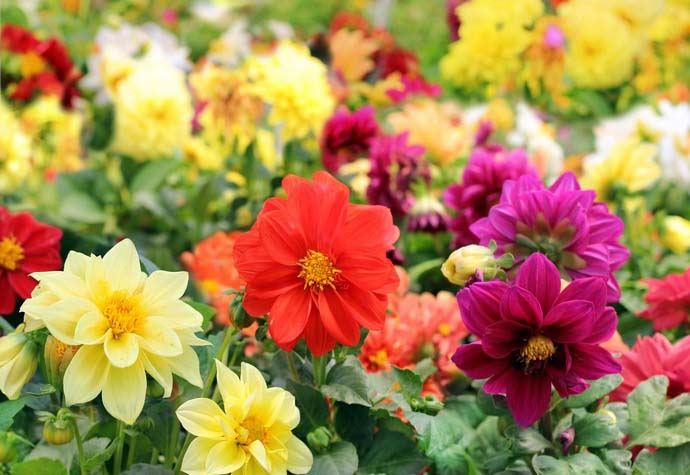

Bambino
Dwarf bushes up to 25 centimeters high. Suitable for flowerpots, pots, for decorating garden gazebos. decoration of flower beds.
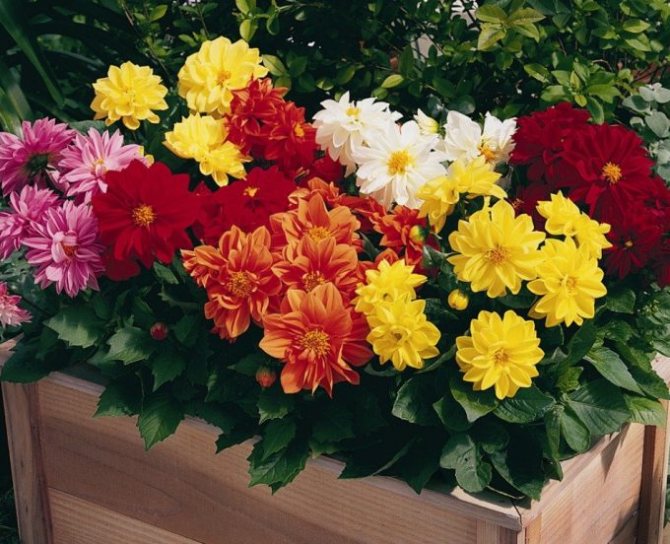

Vasilisa
The color is varied. The height of the flowers is 15 centimeters. It will look perfect on the balcony, on the window in a pot, in the garden in the design of flower beds and borders. The diameter of the inflorescences is 6-7 centimeters. Blooms until frost.
Collared dahlia
Mix of multi-colored flowers. Differs in the structure of the inflorescence. The dahlia has a collar of short petals around a yellow center. Together with large main petals, it forms a beautiful two-layer inflorescence. Designed for bouquets, but also looks great on a flower bed. The height of the bush is 60 centimeters.
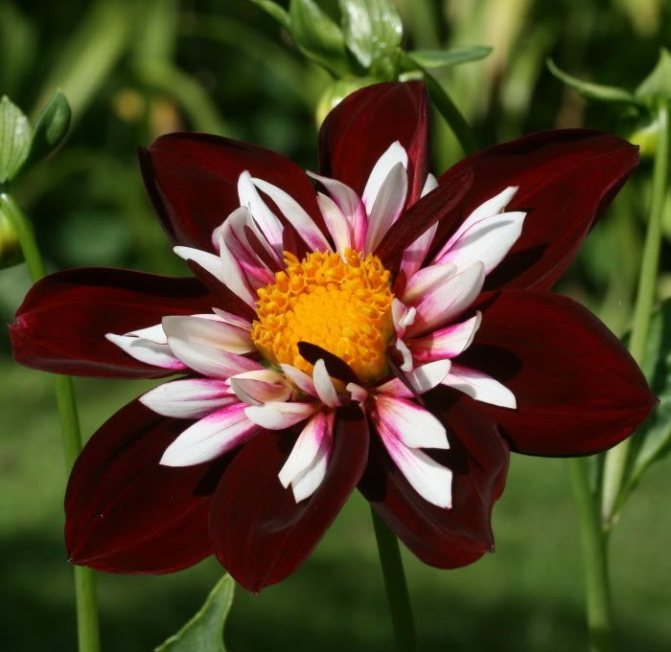

Dandy
Included in the group of collared dahlias. Petals of different color and size make up a beautiful inflorescence with a diameter of 6-8 centimeters. The height of the stems is 50 centimeters. Blooms until late autumn.
Dahlia decorative
Flowers of various colors. Inflorescences are large, round, terry. The height of the stems is 120 cm. Flowers are made up of bouquets. Blooms in the garden until frost.


Cactus
The petals are rolled up into long thin tubes, similar to cactus needles. The inflorescences are large, bright. After planting, they bloom after 16 weeks. But flowering continues until late autumn.
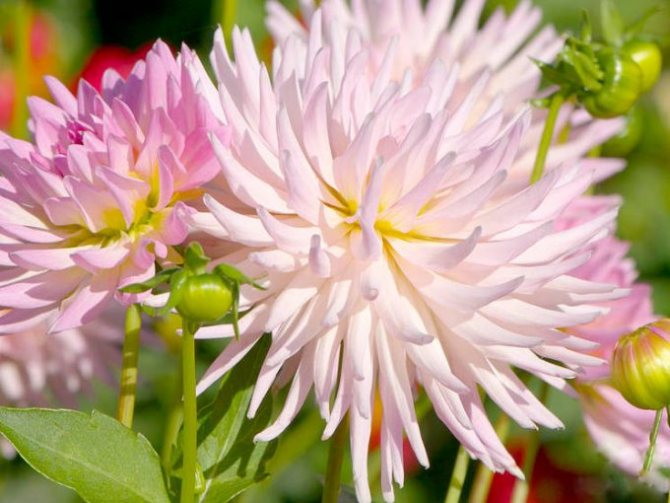

Pomponnaya
Terry dense round inflorescences resemble bright pompons in shape. The height of the bushes is 90 centimeters. Planted in groups.
Opera
Terry inflorescences with a yellowish center. Dwarf plants, only 30 centimeters high. Blooms late, but blooms until late autumn. Suitable for growing on balconies, terraces, gazebos. This variety is used when decorating borders, edging flower beds.
Minion
The flowers are very decorative. The inflorescences are simple, but very bright. They are a decoration of flower beds. Suitable for growing in pots. The height of the bushes is 40 centimeters. They bloom from mid-summer to autumn frosts.
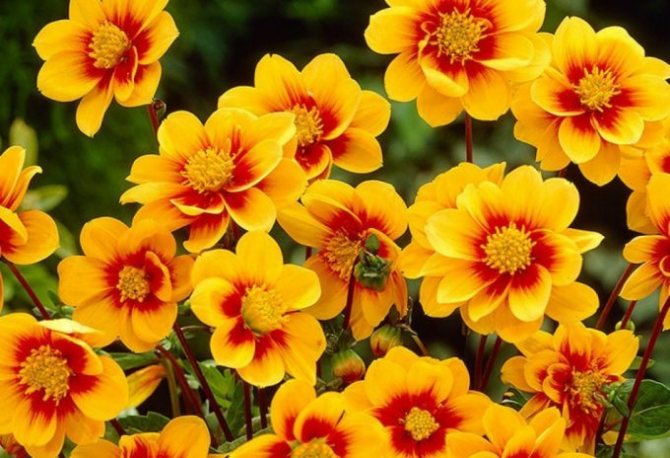

Figaro
Large, up to ten centimeters in diameter, full inflorescences. The color is monochromatic, it can be red, orange, pink, yellow. The height of the stems is up to 35 cm.
Little Tiger (tiger cub)
A bright plant with an unusual color of petals. They are red with white edges. Terry inflorescence. Strong stems up to 50 cm tall.
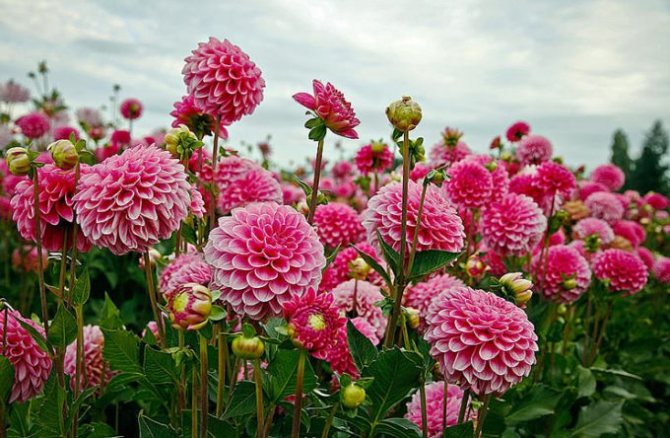

Rigoletto
Inflorescences are semi-double, small. The height of the bush is 50 cm.
Annuals or from seed
For flower growers who are frightened by the chores that are associated with digging and wintering dahlia tubers, dahlias from seeds grown as an annual crop are an exemplary find.
Annual dahlias will also delight you with beautifully attractive, abundant and long flowering, in no way inferior to perennial varieties. Planting and caring for annual dahlias won't give you a lot of trouble either. And we will try with our own advice to reduce your troubles to a minimum.
Planting and caring for annual dahlias is also not a big deal.
It is most advisable to grow dahlias from seeds through seedlings, due to the fact that when sowing them directly into open ground (in the last days of May), you can wait for them to bloom only in the last days of August.
Growing dahlia seedlings is no different from growing seedlings of any other annual crops. At the beginning of April, seeds are sown in plastic containers or mini greenhouses. Calcined sand is used as soil. Seeds are poured onto the surface that is cooked in 1 layer and sprinkled on top with a thin layer of sand.
The required ambient temperature should be within the range of 25–27 ° С. On the 7-10th day, in most cases, seedlings appear, and after 10-12 days you can start picking the seedlings into some small pots.
The soil for seedlings requires loose, moisture-absorbing and fertile soil. You can purchase a mixture that is already ready for use or prepare it on your own: 2 parts of leafy earth and one part of sand and peat. Seven days before the pick, the soil must be brought into the space of the room.
Seeds are sown in plastic containers or mini greenhouses.
3 days before the picking, the ground must first of all be disinfected: for this, the soil mixture is trimmed with a hot (70 ° C) potassium permanganate solution of dark pink color or steamed.
Subsequently, growing dahlia seedlings does not cause big problems. Watering is rare, as the land dries out.
By mid-May, you will have already well-developed seedlings that can be planted outdoors.
Dahlias planted in open ground will not give you a lot of worries in the future. These are drought-resistant plants, thanks to which it is recommended to water them as the earth dries up, no more than 1 time per week. Additional feeding is not required.
Likewise, planting and caring for annual dahlias is a pleasure, in response to which your flowers will thank you with lush and long flowering until the very frost.
Growing problems
Dahlias are susceptible to disease and pest attacks.
Gray rot
The disease begins with the appearance of gray spots on the leaves. Then the leaves turn brown and dry. Unbroken buds fall off. The affected leaves are cut off and burned.
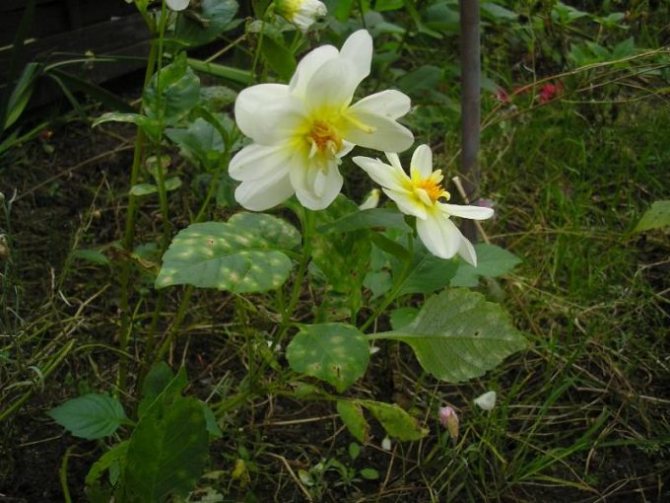

Fusarium
In a plant, the stem rots at the surface of the earth at the junction with the root system. The only control measure is prevention. It is necessary to ensure the air permeability of the soil (loosening, mulching), to prevent stagnation of moisture at the roots.
Aphid
Signs of aphid damage are sharply yellowed leaves twisted into a tube. Parts of the plant affected by aphids are cut off and burned. The bush is treated with Actellik or decoctions of tobacco, garlic, soapy water.
Slugs and bugs
They are less common. Signs are holes in the leaves. They fight against them with Iskra and karbofos drugs. Choosing annual dahlias, you can get an excellent result with a minimum of costs, a real celebration of colors and a variety of shapes.
Now read:
- All the benefits of mulching soil for high yields
- Choosing cucumbers for open ground according to your preferences
- The main technologies for growing peas and caring for them
- Description of 12 types of late varieties of cabbage for planting
About
Chief agronomist of the Limited Liability Company "Association of Peasant (Farming) Farms" Kuznetsovskaya "", Ilovlinsky District of the Volgograd Region.
Perennial
Undoubtedly, planting and caring for perennial dahlias will give you a lot of worries and worries, but you need to agree - wonderful flowers that delight you with their own colors until the very frost are worth it.
When choosing a place for planting dahlias, do not forget that perennial varieties love sunny, wind-protected places.Flowers grow in virtually any soil, the only thing they dislike is very high humidity, so swampy soils are not suitable for them.
In April - May, before planting, dahlia tubers need to be cooked: clean them from dried roots and put them in boxes with any substrate, placing the boxes in a well-lit room at a temperature of 18-22 degrees.
Planting tubers in a box
After about 10 days, when the sprouts appear on the tubers, you can start dividing. Crushing is performed with a sharp knife, carefully so as not to damage the roots, while there must be kidneys on any part.
Then the divided parts of the tubers are again planted in boxes before transplanting into open ground.
Many gardeners ask: how to plant dahlias? We answer. For planting in open ground, holes are made with a depth of approximately the bayonet of a shovel, compost or humus is added to the hole.
The tubers are placed in the hole and sprinkled with earth so that the root collar is not completely covered with earth so that there is no rotting. During the first week, we water it daily, then gradually reduce it, the main thing is that the soil is regularly moist.
In the future, dahlias will not give you big problems and will delight you with their own flowering for many years, some varieties bloom for about three months.
A very important stage in planting and caring for dahlias is the correct organization of the wintering of tubers. Perennial varieties of dahlias do not tolerate frost, so it is necessary to try to dig the tubers before they come.
Planting tubers in a hole in the earth
The day must be dry. Shoots of plants are cut to a height of approximately 20 cm from ground level, the earth around is carefully dug up, trying not to damage the tubers. After that, the tubers are carefully removed from the ground, removing and destroying the patients.
Some growers wash healthy tubers with water, but it is quite possible to do without this, and it is also not very necessary to clean the tubers from the ground. Then the dried tubers are placed in boxes, sprinkled with wooden ash or sawdust.
The boxes are stored in a cool, well-ventilated room with an air temperature of 5-7 degrees, very often in the basement. If you do not have a basement, then you can keep the boxes at home, but the temperature should not be higher than 20 degrees, and the tubers are sprinkled with earth, and the boxes are tightly covered with paper. Once throughout the month, you need to look at the tubers for the timely detection of diseases.
What to do with dahlias in autumn
Dahlias are thermophilic plants. In winter they almost always freeze out. Therefore, they are always dug up in the fall.
Popular: Frost-resistant varieties of the Canadian rose and care for them
You can try to save and plant the tubers of annual dahlias for the next year. The bush will turn out to be stronger and more luxuriant and retain all the qualities of the mother plant. Not all information is transmitted by seeds, for example, the color shade may not be the same as that of the original plant. When preserving the tubers of one-year-olds, difficulties can arise, since the roots are small and quickly lose moisture.
Preparing tubers for storage
Previously, at the beginning of autumn, dahlias, whose tubers will be intended for conservation, are huddled in order to prevent the death of the root system from a sudden cold snap. At the first frost, the leaves and stems of the dahlia turn black.
- They must be cut off, leaving five centimeters of the stem above the ground;
- Dig out the rhizome carefully so as not to damage the thin tubers (two weeks after the first frost);
- Wash selected undamaged tubers;
- Soak in a 1% solution of potassium permanganate for disinfection;
- In a warm room, the roots must be dried.
For storage, use cardboard boxes with sawdust or sand. The tubers should not be in contact with each other. They can be stacked in layers.Sometimes, in a warm winter and good snow cover, the dahlias remaining for the winter do not freeze, in the spring they germinate and turn into a lush bush.
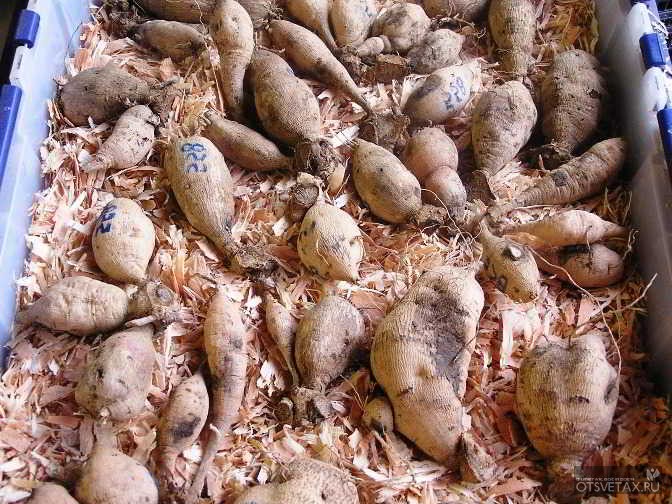

Diseases and pests
Like all flowers, dahlias are prone to diseases and pests. In this part of our publication, we will talk about the key diseases and pests of dahlias. We start with diseases:
- Botrytis, or gray rot, - brown spots appear on the leaves, then the leaves gradually dry up and fall off. All parts of the plant are affected, the buds do not open, the plant dries up. The reason for the development of this disease is very high humidity, due to this, very often it appears in spring or autumn when the weather changes. Deep necrosis appears on the tubers, such tubers rot during storage.
- Sclerotinosis, or white rot, is also a fungal disease in which individual shoots are affected, brown spots appear on the stems, and also white mycelium with black sclerotia.
- Verticillium and Fusarium wilting is characterized by rotting of the root system and tubers, the parts of the plants located below turn brown, the tops and buds fade. The affected parts of the plant are covered with a brown or white-pink bloom. Tubers are also not stored during winter - they dry out and shrivel.
Verticillium and Fusarium wilting
How to deal with dahlia fungal diseases? There are no drastic measures for this. The very first thing you need is an accurate choice of a place for planting dahlias, avoiding very high humidity.
And if you have met with one of the diseases, then the actual culling of diseased plants and the elimination of diseased material can help you.
Also, your dahlias can be attacked by pests. It is necessary to dwell in detail on the key pests and measures to combat them:
- Aphids are, for sure, a well-known pest of not only dahlia, but all plants in your garden or vegetable garden. Colonies in most cases are perfectly visible to the untrained eye. Also signs of damage - yellowing and curly foliage, the presence of "honeydew" - sticky aphid secretions on the foliage. Control measures: with single colonies, they are cut off simultaneously with the leaves, with multiple lesions - treatment with insecticidal preparations.
Aphid
- Herbivorous bugs, feeding on leaf blades, disrupt the flow of nutrients, yellow spots appear on the leaves, later brown spots. Subsequently, the tissues of the leaf are wrinkled and torn with the formation of holes of complex shape. Control measures: with a small degree of damage - treatment with a solution of green soap, with large volumes of damage, they resort to the use of chemistry. You need to process in the morning.
Herbivorous bugs
- Slugs. These gastropods are lured by juicy dahlia leaves, first of all they eat grooves in the leaves, then they can gnaw through the leaves. Control measures: mechanical collection of pests, also successfully scattering between plantings of substances, "dragon" tentacles of mollusks - wood sawdust, red pepper, superphosphate.
Slugs
We hope that in our publication you have found answers to many questions regarding how to care for dahlias. And let your plants bring joy to you with their own luxurious flowering for more than a dozen years!
Transplanting seedlings


Where to grow dahlias
Young dahlias should be transplanted after warm weather sets in, otherwise the last frost can destroy the plants.
In order for the seedlings to acclimatize better, in about two weeks they need to begin to "accustom" them to natural conditions. In sunny weather, it is taken out into the fresh air, first for five minutes, then for ten, gradually increasing the time the seedlings stay outside. The planting process itself is as follows:
- A couple of hours before transplanting, the soil in the containers should be well moistened (if they grow in cups made of peat or paper, this can be omitted).
- The landing site has been prepared since the fall. A well-lit, draft-protected area is chosen, best of all with loose soil that has neutral or low acidity. It needs to be fed with organic and mineral fertilizers, and if the soil is too acidic, add a little lime. After that, dig up the ground well and make markings for the beds.
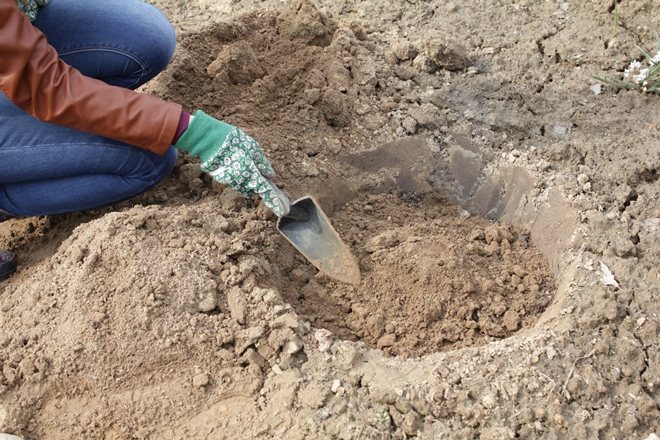

Landing fossa - In the spring, small holes are dug in the selected area, and a pinch of ash and a little compost are added there, mixing them well with the ground.
It is important that there is a sufficient distance between the holes - if the selected variety of flowers is high, it should be at least 70 cm, for low - about 50, for dwarf - 20-30 cm.
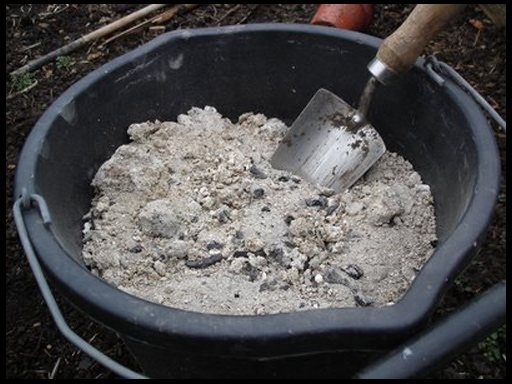

Wood ash - Plant seedlings in the holes (if they have grown strongly, you need to deepen them to the first lower leaves), water and mulch the soil.
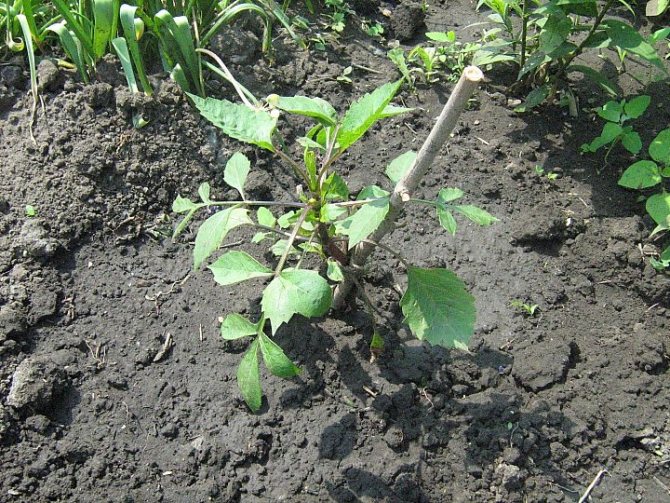

Seedlings planted in the ground
Dahlia seeds can be planted directly in open ground. This is done not earlier than the end of May - the seeds are sown, covered with foil and looked after in the same way as for any other annual crops. True, the first flowers in this case will appear only towards the end of summer.


Root tubers of annual dahlias


Planting dahlias in open ground
Question to those who sowed a Dahlia ANNUAL) ??
I sowed seedlings in the last days of March, but maybe if they sow today it will turn green, but closer to the beginning of autumn. As for the seeds, if not hybrids and have time to ripen, you can collect. And if you wish, you can dig the tubers in the fall, save them and plant them in the spring.
—- † Crypt Motorcyclist † —-
immediately into the soil as it warms up under the film, the seeds will be in the fall. Why do you need a one-year-old, suffer with it, you can plant a perennial one, there are 1500 kinds of varieties.
Elena Mango
I sow an annual dahlia every year. It can be both cactus-like and pompom, which does not stand out from perennial, tall ones. I plant seedlings, as they will not withstand frost. The seeds have time to ripen. Collect.
Great to sow in a greenhouse, then plant. The seeds will ripen. Mine have already ascended. if they bloom late into the soil right away.
Valery Azachem
What are the seeds for. I leave the tubers for the winter - as with perennials - and complete order (only the tubers of the one-year-old are very small, based on this, they dry out more quickly). But - for full growth it is enough. In addition, virtually every year I renew the diversity through the purchase of seeds.
Valentina Pushenko
And not only that, you can dig roots in the fall. Store in a basement or at home under a balcony door. Success.
I also saved tubers
seeds directly into the ground, blooms all autumn until frost, and the seeds can be harvested.
Olga Afonina
I often sow annual dahlias. I love varieties with, in other words, "collars" like Dandy. Yes, and there are many others nowadays. But regarding the safety of the tubers, I will say this - I planted one-year-olds, bloomed beautifully and threw them out in the fall and my soul does not hurt, but how will those tubers overwinter? ? In the spring I bought again what I liked and the process is repeated. Of course, I don't even argue, tuberous ones are more beautiful and more luxurious than sowing ones, but when there was a collection of 80 varieties and in one of the winters in the cellar in the garage everything disappeared, I made conclusions in the direction of sowing dahlias.
I dug up the tubers of annual dahlias and saved them. now I sprout them for planting in the
Galina Tsikalova
... sii. first of all, do only as Brunetka writes - COLLECT SEEDS.
very grateful flower. I planted it with seedlings in March and a bunch of everything else (petunias, asters, zinnias, carnations, purslane.), Only dahlias bring joy !! ! I have already decided the next year - just him. And there are such attractive varieties.
Olga Vasilievna
I buy the seeds I like, I grow them through seedlings.
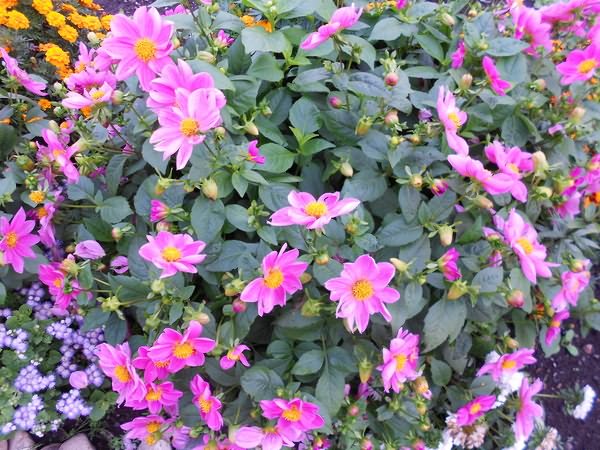

And I sow (North of the Moscow region) in a greenhouse, for seedlings, In the fall, I do not collect and do not store anything, I have already played enough with digging and storing.
You can directly into the soil
It's a trifle to grow them, in March for seedlings, now they are sitting, 9 I will plant in a flower bed. You don't need to dig it out or keep it in the cold, the variety is a wonderful get-together, funny guys.
Description
Dahlia belongs to the Asteraceae family. Its plants can be annual or perennial, and many gardeners prefer the first type. The fact is that this thermophilic flower cannot winter in the middle lane, so the tubers have to be processed and stored until the next sowing. This creates certain difficulties, since during the winter they are often affected by diseases and dry up, so it is much easier to grow annual dahlias.
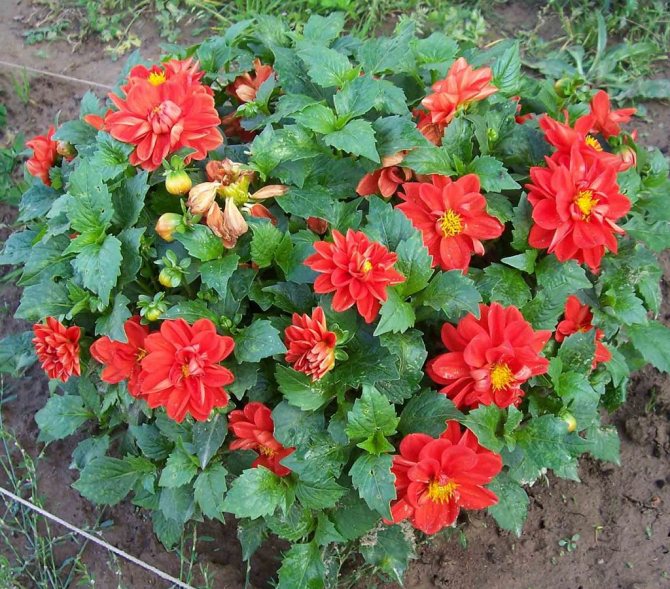

Bush of annual dahlias
In terms of their decorative properties, they do not differ at all from their perennial counterparts. These are low (about 80-120 cm) plants, the diameter of the flowers is about 10-12 cm, and 10-15 flowers can bloom on one stem at once. They bloom in June-July, and retain their bright colors until late autumn.
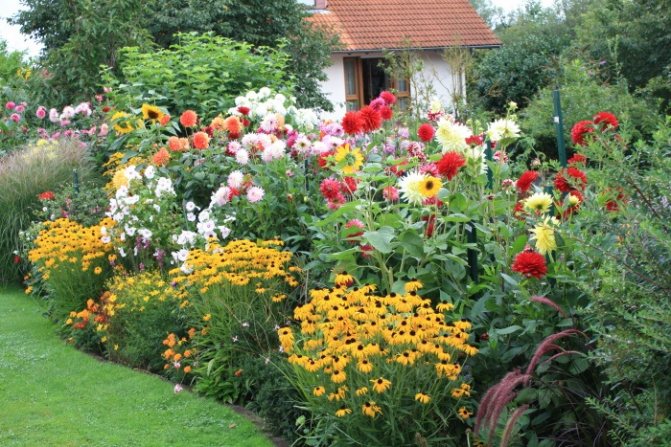

Dahlias - queens of the autumn garden
Growing dahlias from seeds is easy
The time of flowering of dahlias is coming to an end. A very wide variety of size, shape and color of inflorescences, high variability in height and strength of growth, versatility of application made these plants unusually common among flower growers. In our conditions, dahlias can be grown in perennial or annual crops. The first method is more widespread and is based on the ability of dahlias to form underground root tubers by the end of summer, containing deposits of nutrients and recovery buds. Root tubers do not hibernate in the ground and due to this they are dug up and stored until spring in dry, cool rooms. In most cases, expensive varieties of dahlias are grown in a perennial culture, propagated only by vegetative means. However, this method is quite laborious, expensive and unproductive, therefore, during storage, the root tubers do not tolerate freezing at all and often rot.
Growing dahlias is also possible in an annual culture by seed reproduction. It is very promising to grow annual dahlias from seeds, since the plants bloom during the year of sowing, and there is no need to store root tubers. Moreover, the seeds can be completely collected by ourselves. In our country, for those who love annual dahlias, the cultivation of such flowers from seeds has become a good tradition, in most cases the seeds are propagated by the domestic mixture of non-double dahlias Merry Guys, and also semi-double mixtures of the foreign selection of Figaro and Rigoletto. Nowadays, on sale you can find dahlia seeds of English selection with the name Pompon Mixt - a mixture of pompom dahlias, Unwins Dwarf Highbrides and Unwins Gypsy Dane - mixtures of dwarf semi-double dahlias, Hast Dandy - a mixture of collar dahlias, etc. In addition, in the West it is successful from seeds grow dahlias from groups of cactus, decorative, spherical.
The research made it possible to evaluate the cultivation of dahlia from seeds of foreign selection under our conditions. When planted on seedlings in March, the plants bloom together in the last days of July - early August. At the same time, the mixtures are distinguished by their alignment according to important characteristics, differing, as a rule, only in the richness of the inflorescence coloring.
Dahlia care
A little care needs to be taken about the soil. The soil should be:
- nutritious;
- loose;
- permeable;
- in composition, neutral or slightly acidic.
Fertilizers can be applied to scarce soils in the fall. In terms of mineral composition, it is preferable to potash and phosphorus. With an excess of nitrogen, plants may have developed leaves and not bloom. Dahlias will feel good if you add a handful of wood ash to each hole before planting.
Watering
Dahlias are watered only as the soil dries up. It is important to avoid waterlogging, as it can cause fungal diseases, which are very susceptible to flowers. With the onset of autumn, watering is stopped.
Loosening
carried out after watering or rain. The procedure allows nutrients and moisture to penetrate faster to the roots. The air permeability of the soil increases, which will prevent the development of fungal infections.
Mulching
After loosening, the plants are mulched. This will prevent the emergence of weeds, protect the root system from drying out. Peat, compost, tree bark, sawdust are used as mulch.
Top dressing
Fertilizers are applied for abundant flowering:
- before flowering;
- after the first flowers appear.
Pruning
- To make the bush lush, in the spring the central shoot is pinched off the plant. This stimulates the appearance of lateral processes with new inflorescences. The exception is curb varieties ("funny guys", for example). They themselves form lush bushes with multiple flowers;
- Faded flowers must be cut off. Only a few inflorescences are left to ripen before seeds appear.
In autumn, if there is a threat of early frosts, dahlias are covered overnight to prolong flowering.
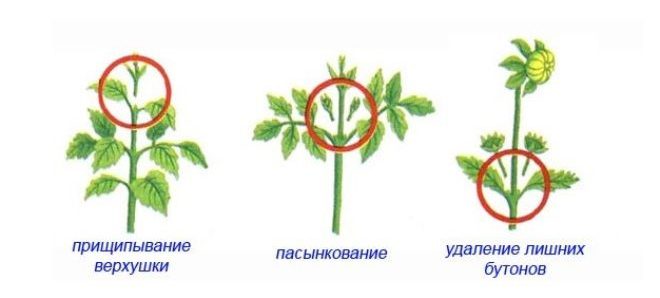

Annual dahlia varieties
Pompom Mix is provided by tall plants of 70-120 cm with graceful very small pompom inflorescences placed on strong, long peduncles. At the same time, up to 16 inflorescences bloom on the bush, and up to 40 inflorescences on individual plants. The mixture is recommended for creating tall curbs and even more so for cutting.
Mixes of Unwins Drif Highbreads and Unwins Gypsy Dane are represented by low-growing, up to 60-70 cm, semi-double dahlias from the single-row and peony classes with very different inflorescence colors. Spreading bushes, strongly leafy. The color of the leaves changes from light green to purple. At the same time, up to 10 inflorescences bloom on the bushes. These mixtures are recommended for creating flower beds, flower beds, low borders, and also for cutting planting.
The Hast Dandy mixture is a mixture of unusual low-growing dahlias 35-55 cm high with a collar type of inflorescences. Dense, well-leaved bushes bear from 6 to 15 simultaneously opened inflorescences. In other words, the petals are red, crimson or lilac, inside they are trimmed with a white or yellow collar. Plants are extremely good for creating short, variegated, well-flowering borders, suitable for growing in containers, can be used for cutting.
how are dahlia seeds harvested?
dissenting
Even if you collect seeds of varietal plants, that is, not F1 hybrids, you should choose only the best specimens for reproduction: with a beautiful color and shape of flowers or inflorescences, optimal sizes, abundantly blooming. Attach labels to them or tie them with pieces of twine, and when the plants have faded, it will be easy for you to figure out where to harvest the seeds.
Polina Vysotskaya
Annual dahlias look very good, if you plant several varieties together, in tiers - from undersized (height about 20-30 cm) to high (more than a meter). Always bright, always blooming, pleasing to the eye. As far as I remember, cactus annuals are about a meter high.
Only from fully ripe and healthy fruits. If somewhere we notice cracks or signs of a disease, then we immediately discard such a fruit.schizanthus - the nightshade family. 3-4 years:
Hedgehog
We place the boxes in a warm, dry place with good ventilation.
Why growing dahlias from seeds is so in demand
Dahlias grown from seeds, in our conditions, not only bloom well, but also bear fruit. In order to get your seeds, at the end of the growing season you need to collect the ripe baskets, dry them and thresh them. Plants grown from such seeds are not inferior to their parental forms in their own decorativeness.Moreover, the plants you like can be subsequently grown as perennials, digging and preserving root tubers every year. And, in the end, seed reproduction will provide an opportunity for everyone to become a breeder, select and multiply valuable forms and create original, unique collections of dahlias - dahlia.
We collect seeds: what, where, when and how
Similar articles
Hybrids
There are perennial cactus, they have large rhizomes (or potatoes).
Crossroads and self-pollinators
Levkoy,
Escholzia and argemonta are the poppy family.
Guess the moment
Calendula,How to properly collect the seeds, we figured out. Now, an equally important question is how to save them.This must be done when the fruits located in the lower part of the peduncle begin to crack. The upper part of the peduncle, on which the green fruits, are cut off and discarded. For the rest of the shoot, we put on a narrow paper bag, for example, the one used to pack a baguette. We tie the package from below with a rope and cut off the peduncle below the package. Turn the package over - the seeds spill out of the boxes. Since the seeds spill out gradually, we hang the bag in a dry, warm room and wait. The indicator for collecting the seeds of this crop is wax ripeness. Then you need to ripen them. Such precautions are necessary so that the capsules do not open and the seeds do not spill out ahead of time.To stimulate the appearance of new buds, faded inflorescences need to be cut off. Flowering usually lasts until late autumn. If the first frosts appear early in your area, we recommend covering the plants with agrofibre or other non-woven material. The next stage is the isolation of seeds from the fluff and their cleaning. To do this, use various sieves - a sieve for flour, a colander is suitable. First, use a sieve with larger holes to separate coarse debris. Then filter out the dust through a fine sieve. When you have a fraction of the debris, commensurate with the seeds, they can be separated in several ways., Collect seeds in your garden - what could be easier? However, such a thought does not even occur to the majority. We hope these tips will help you get your own harvest.And there are cactus annuals. Sowed, terry with curling petals really grew. And I tried to preserve the roots of annual dahlias, "the game is not worth the candle," they take up a lot of space, they are stored much worse than perennial ones. It is better to buy seeds and sow again, especially since they are always on sale. And what kinds of varieties are not there !! ! I also liked Dandies. And if you buy several varieties, collect seeds, then next year you will get something that you cannot buy in a store. They are pollinated, it turns out something new. Lobularia - cabbage family;4 - 5 years old: Marigolds,Even if it seems to you that the seeds are completely dry, it is still not worth the risk, they need to be dried. There are other ways to harvest the seeds of these crops. You can cut off the entire peduncle completely, when at least a few of the lower bolls turn brown, lay it out in a dry place and wait until some of the upper bolls mature. And you can collect seeds gradually, picking only ripe bolls. But the fruits of balsam cannot be cut off in advance, since ripening will not give an effect - the boxes will not open, and the seeds inside will rot. Balsam must be cut off at the time of ripening. How to determine this? Rub the shutters of the fruit in your hands, if they open, then you can already collect the seeds, since they are ripe. Collect balsam seeds very carefully and carefully, as the fruits can crack right in the hands.It often happens that the first tested variety is to your liking and there is a desire to decorate the lawn with it next year. You just need to learn how to collect the seeds of annual dahlias and use them in the spring.To do this, let the flower dry on the bush. Gently pick the inflorescence, remove the dry petals, and put the seeds on a sheet of paper to dry. Store seeds in a paper bag in a dry place. Sign the package so as not to be mistaken with the variety.
Blowing in the wind
Collecting seeds: when and how
Viola
Where to store
Not every plant can collect seeds. F1 hybrids occupy a significant part in the assortment of ornamental and vegetable crops. Some of them are sterile, that is, they do not produce seeds at all. In others, the seeds set well, but the plants grown from them can be very different from the original ones, and not for the better. If you do not strive for the ideal, take a chance - sometimes you get a very interesting result, especially since when collecting seeds you do not always know whether it is a hybrid or a variety. Of course, a trial batch of seeds should not be sown in the most visible flower bed.
After collecting
By the way, perennials have a much larger flower.
Amaranth and cellozia are the amaranth family.
Petunia,
Arctotis,
We lay out all the testes, capsules, heads, pods and inflorescences in separate boxes or other containers, placing paper, linen or netting so that the fruits can dry out from all sides and do not rot or mold anywhere from the accumulation of moisture.
Selectively pick off dried fruit, in which brown or black seeds. Alternatively, you can cut the whole plant when most of the seeds are mature.
They begin to collect them when their fruit-beans turn yellow and begin to dry out. We collect selectively and in several steps. Note that ripe fruits of these crops will crack.
You can take seeds from the variety "Merry Guys" - on faded inflorescences.
On a windy dry day, a piece of cloth or thick paper is spread outside and, raising the container with seeds about a meter from the ground, the seeds are slowly poured onto the cloth. Heavier seeds fall down, and light debris is blown away by the wind. You can do this at home using a hairdryer.
,
According to the method of pollination, all plants are divided into crossroads and self-pollinators. In the latter (among ornamental plants these are annual asters, sweet peas, levkoy and some others), each flower pollinates itself, therefore almost all plants obtained from such seeds will be similar to the original ones. At the crossroads (ageratum, snapdragon, gelichrisum, marigolds, carnations, calendula, nasturtium), different specimens are pollinated among themselves. If different varieties of a cross-pollinated crop grow close to each other, then the plants obtained from their seeds can either be similar to one of the parents, or differ significantly from them. By sowing such seeds, you can get not only a beautiful mixture, but also specimens with unusual characteristics that can become the founders of a new variety. If you want pure-bore seeds, you only need to plant one cross-pollinated variety.
It will bloom in summer, it is annual. If you want to get seeds, sow seedlings in April, after the end of the night spring-summer frosts, plant them in open ground. I have a front garden next to the house, I cover the flowers at night (if frost is expected). If the seeds are not needed, sow them in the ground, I sort of sowed them at the beginning of May. Do not be afraid, they will bloom. Choose a sunny place, the bushes will not stretch out.
Features of growing seedlings
After the first shoots appear, the film is removed. This usually happens 2-3 days after disembarkation. Watering young seedlings is advised with a spray bottle. This method prevents soil erosion.
When do annual dahlias dive? Experts recommend doing this if 2-3 true leaves have appeared on the seedlings. They usually grow 2 weeks after germination. When picking, they are well buried, the stem with the root part goes down to the first leaves.
Testimonials
Diana Ufimskaya
“Previously, the dahlia was called the queen of flowers. Without them, there were no bouquets, teachers were always given gifts in the fall. Most of all I like pink ones with a red center. "
Nika Davletova
“When collecting seeds, I made a mistake - I cut the baskets while still damp. Now the inflorescences have dried up, but I never dreamed of seeds to multiply. But I have already bought a lot of annuals for the next season. I'm just in love with dahlias: a little trouble, but such a beauty! "
HOW TO CORRECTLY COLLECT AND STORE PLANT SEEDS
We cut off the entire flowering shoot entirely, when the lower flowers turn brown, we do not wait for the browning of the entire inflorescence. If you wait, the seeds will crumble. We lay out cut peduncles in a dry place for ripening.
The most difficult thing is not to watch out for the moment X. It is better to collect the seeds in the morning, so that the air is not as dry as in the daytime, in which case the valves do not crack. We break off the fruits at the stage of maturity and wrap them in paper or a linen bag, where the seeds can spill out. Seed pods are collected selectively, as they ripen.
if the fruits are scattering seeds
Country House - Dahlias
Pour a little heap of seeds into a large flat plate, tilt it slightly and shake it with quick short movements. In this case, the seeds are poured into the lower part of the plate, and the garbage rises upward.
How to collect geranium seeds
In crops with amicably ripening or well-ripening seeds (gypsophila, lobularia, lobelia, nigella, snapdragon, phlox drummond, iberis, cornflower, godetia, clarkia, flax, nemesia, schizanthus, carnation, forget-me-not), as a rule, the whole plant is cut entirely at the moment when most of the seeds are ripe and the pods or pods began to open. In other species -
How to collect pansy seeds
Once again, the annual dahlia blooms in the very first year. And do not suffer, do not store annual tubers. Then it's better to buy perennials.
How to collect balsam seeds
We cut the fruit in half and take out the inner pulp (core) with seeds into a container (plastic cup or cut plastic bottle), where fermentation will take place. The temperature in the room where the fermentation vessel is placed must be above +25 ° C. After about a day or two, we wash the seeds. To do this, fill the glass with water, stir the contents so as to remove the remnants of the fruit pulp. When only clean seeds remain at the bottom, and the water in the glass is clear, stop rinsing, drain the water and pour the seeds onto newspaper or paper. We dry the seeds for 3 - 4 days, keeping the temperature +28 - +30 ° С. Mix the seeds once or twice a day. After complete drying, pour into a paper envelope and store in a dry place.
Lupine and Sweet Pea Seeds
More than 5 years:
How to Harvest Drummond Phlox Seeds
Cloves,
How to collect viola, cleoma, escholzia seeds
From time to time we mix the seeds and make sure that mold does not appear anywhere.
if the seeds develop in the inflorescence basket
Seeds of asters, gatsania, arktotis, rodante, helihrizum
We cut off the entire inflorescence as a whole, when most of the boxes (pods) dry up and take on a brown color.
It is necessary to collect them when the baskets brighten, then they should completely close or a fluff will appear in the center of the inflorescence.
How to collect marigold and carnation seeds
Dahlia is a perennial tuberous plant with amazingly beautiful flowers, attracting attention with a variety of forms and a bright, cheerful color.
How to collect dahlia seeds
Rolling round seeds on a plate or thick paper
How to collect zinnia seeds
And others - the seeds are collected selectively, in several stages, as they ripen.
Seeds of calendula, string and cosmos
Dahlia
Perennial: reproduce by dividing corms….Yes, and Merry Guys can be used as perennials, if the root ripens. Cucumber fruits left on the seeds, the so-called "yellows", should acquire a slightly brownish tint on the beds and become covered with small cracks / scratches. Then you can pluck them and get the seeds. Cut the cucumber and take out the seeds into a container. Then we rinse them thoroughly to get rid of the stuck cucumber pulp as much as possible.
Sunflower seeds
Lupine,
if the fruits ripen unevenly
How to collect foxglove, delphinium, mallow, snapdragon, mullein and clarkia seeds
Resin,
When the seeds are completely dry, thresh them, removing excess debris. In some cases, you can use a sieve.
How to collect Lavatera seeds
We cut off the whole plant when the first lower capsules turn black. Then we spread it out for ripening for at least 1 month.
How to collect seeds of petunia, purslane, scented tobacco, morning glory
If a rainy rainy autumn is foreseen, then you can collect the baskets in advance, without waiting for the appearance of the gun, but be sure only after the flower withers. Then the boxes should be left for ripening. If asters and gatsanias did not have time to form seeds, this happens in late-flowering species, then they can be transferred to a warm (greenhouse, veranda or other cool room) place, completely dug up and transplanted into a pot.
How to collect Salvia seeds
Ysadba.org
How to collect seeds of verbena, lobelia, mattiola two-horned, nigella, flax, nemesia, godetia, schizanthus, toadflax
Seeds are poured in small portions on one side of the leaf, tilt the leaf so that the heap is at the top, and shake slightly. Round seeds are poured into a box placed underneath, and the debris remains on the paper.
How to collect Anhuza seeds
Baskets of asters, gelichrizums, acroclinums are collected when all the petals are dry, and a fluff appears in the center of the inflorescence. Marigold baskets are harvested a little earlier, when the petals have already withered, and the filmy cup-wrapper at the base of the inflorescence has not yet dried. The seeds of annual dahlias are best harvested when the fruits are dry, but you can do this earlier, since the seeds of this crop can be ripened. Green, not dried seed-nuts are also collected from nasturtium, but only those that have reached large sizes and easily crumble when touched. Such seeds also need to be ripened for 2-3 weeks at room temperature (20-25 ° C). But in cosmos and calendula, the seeds are almost never ripened, so they need to be harvested ripe and almost completely dry.
How to collect kermek seeds
,
if the fruits ripen evenly
Well, up to a meter, there is a lot of undergrowth, maybe they were fed badly.
if the fruit does not crack
How to collect cornflower and levkoe seeds
Put the washed seeds on paper to dry. We dry for a week or two, as it turns out. Then we hide it in a dark place in a paper bag for storage.
if the seeds fall at the same time
How to collect seeds of amaranth, cochia, resin, Drummond phlox, alissum, mignonette, celosia, iberis.
Dolichos,
Gypsophila - the whole family of cloves;
How to collect nasturtium seeds
Important! Containers with plant fruits that scatter seeds over long distances (Drummond phlox, pansies, escholzia, sweet peas) should be covered with gauze or cloth.
Browned or turned yellow shields, in which burnt-out, pale cups-funnels, are subjected to selective cutting.
rules for storing seeds
To collect the seeds of this culture, the filmy cup-wrapper should turn yellow and dry, and the petals should dry completely. If it is rainy weather, then it is better not to wait for the seeds to ripen, as they are more likely to rot than ripen. In this case, we remove the inflorescences after the petals begin to wither and leave them for ripening.
Pick now the faded and dried flowers ... lie in a dry place, ripen, then just peel the flowers and there will be seeds
Drying rules:
- Dahlias are wonderful garden flowers that amaze with a variety of colors and splendor of buds. There is hardly a person who is indifferent to their magnificence and grace. However, many of the gardeners do not like to tinker with perennial varieties that require special care in the fall in preparation for wintering. But there is a way out - growing annual dahlias. Caring for them is much easier, and besides, the flower pattern in the lawn can be updated annually at your discretion. True, it is still worth getting acquainted with the peculiarities of growing and caring for annual dahlias.
- It is advisable to do this on a clear dry day. If the fruits of the plant do not crack, and the seeds do not scatter, as, for example, in most Asteraceae, the collection is carried out in the afternoon, when the dew is completely dry. If the fruits can crack (viola, balsam, escholzia, cleoma, etc.), it is better to collect in the morning, until the capsules or pods are dry and the seeds have not scattered.
- Aster
- And I dig up annuals, store them in a cool meta and plant them together with large - and normally - large and beautiful ones.
- In order not to lose the "bulbs" of the onion, the arrow with the seeds should be wrapped in cheesecloth, as in a bag. Then the ripe seeds will fall directly into the cheesecloth. All that remains is to collect them, then dry and store in a ventilated area. You can also pick the arrow with the seeds during the period when there are at least a few fully ripe seeds and ripen them in a warm, dry place on the canvas.
Rank - a family of legumes;
Storage rules:
- Panstemon,
- We put the peeled seeds in paper bags, envelopes or linen bags. We sign each one, not forgetting to indicate not only the variety and culture, but also the year of seed collection.
You can collect seeds of gypsophila, vaccaria, xerantemum like this: tie shoots and fruits into a bunch, tied with a lace. Then we cut off the stem below the bandage. The cut stems must be hung with the slices up and a piece of paper or linen should be placed under them so that the seeds can fall on it.The optimal time for collecting dahlia seeds is when the fruits dry up and the scales begin to diverge in different directions. But it is also not necessary to wait for the seeds to fully ripen. For example, if there is frost on the nose, then you can pick off the green inflorescences.
How to properly collect and store plant seeds
Preservation of germination of flower seeds:
Popular is the bright dwarf variety of annual dahlias "Merry Boys" with various colors of tubular flowers up to 10 cm in diameter. The cheerful colors of the undersized variety "Piccolo" (up to 45 cm) often decorate lawns, pots and small flower beds. Among the annual low-growing dahlias, the variety "Dandy" is also of interest, the stems of which are decorated with unusual semi-double collar flowers. There are also varieties "Lark", "Unvis Dwarf", "Mary" and others. But basically, annual dahlias are characterized by a height of up to 60 cm and flowering from July until the first frost.
- Seeds are best collected in paper bags or cloth bags. If there are few seeds, they can be left in the same bags, placed more freely in boxes and taken to a warm, dry room. On each package, you must write the name of the crop, variety and date of collection. If there are a lot of seeds or you have cut the plants completely, they can be scattered in boxes in a thin layer or placed on sheets of paper laid somewhere in a barn, in an attic or in another warm and dry place. Each sample is labeled with the crop, variety and date of collection. Be sure to cover cracking pods and pods with paper to prevent the seeds from scattering.
- ,
- Tuber in the fall like ordinary dahlias, I think that you can save until spring and plant on the trail. year.
- It's very simple - we collect yellowed or brown pods with seeds. Then we open / exfoliate them over the container, where the radish seeds themselves pour out.
Coleus,
- Snapdragon,
- It is necessary to store seeds at a temperature of 0 - +10 ° C, a relative humidity of 60%.
- Since the fruits do not have the property of cracking, it is necessary to wait until the fruits are fully ripe. Then we cut off the whole plant or pull it out with the roots, hang it tied in a dry place to dry it.
- The signal for collecting seeds is the brownish and starting to dry out inflorescences-baskets.
- Problems with collecting seeds are not only for beginners, but also for experienced gardeners and gardeners. For example, if a crop is grown for the first year or seeds from such plants have never been collected, then even an experienced amateur gardener may think about how to correctly collect flower seeds in certain cases. Today in this article we will talk about ways to collect seeds from different types of fruits and plants.
- As a rule, these plants are planted outdoors through seedlings. This will allow you to enjoy the first flowering at the end of June - at the beginning of July. Growing annual dahlias from seeds, by the way, is not such a laborious task.
- Dry
- Marigolds
- I have 4 cactus dahlias - Apache, Chacha (although it looks more like a decorative one, it is called cactus), Yellow Star and Tsukki - Yori, but I bought them not with seeds, but with rhizomes. Form new tubers gracefully
- No harder than dill seeds. Ripe - blackened or brownish carrot seeds on an umbrella, shake off or pluck into a container for seeds and dry.
Sage is a family of labiates.
- Nemesia - the whole family of norichnikov;
- Important!
- The fruits of these crops are opened very slowly, moreover, not at the same time. If you wait for them to fully ripen, you may not get seeds at all, since with the onset of autumn they will begin to become moldy. Cut the fruits in advance and dry and ripen in a warm place.
It is necessary to collect the seeds of these plants in the phase of almost complete maturity in several stages. By this time, the seeds should dry out and take on a yellow-brown and black color.
- Probably one of the most controversial cases is when the seeds are scattered over long distances. So you don't know whether to pick the fruits in advance and ripen them, or you still need to wait for full ripening and seize the moment in order to have time to collect the seeds before they are scattered tens of meters around. There are little tricks to keep the seeds from these plants as much as possible.
- In a seedling container (box, basin, wide pot), plant seeds are placed on moist soil, covered with a small layer of sand, and slightly trampled. The seeds are planted at the end of April. The container is placed in a room with a temperature of 23-25 degrees. A few weeks later, when shoots appear, the seedlings dive into separate cups or pots. In open ground, seedlings are planted in May, when the danger of frost has passed. You can sow seeds in open ground in mid-May.
- It is necessary to dry the seeds at a temperature of 20 to 30-35 ° C, periodically turning the plants, stirring the heap (fruits with seeds) or shaking the bags. Finish drying when the mass seems dry, and the leaves, bolls, twigs break easily when bent.
- ,
- Cactus is about the shape of petals in a flower
When the entire inflorescence turns brown, the seeds will ripen completely. You can pluck the entire inflorescence entirely. We put them in a container where they can dry completely within 1 - 1.5 months. Then we grind them on a sieve, wind them in the wind to remove the remnants of inflorescences and debris. Dry the peeled phacelia seeds.
- More than 6 years:
- Mallow,
- Do not store seeds in rooms with high humidity: in the kitchen or in the bathroom. Also, do not use plastic bags or plastic containers.
- There is another way: under a plant with partially ripe seeds, we substitute a large, wide container (for example, a plastic basin), shake the plant, the seeds should pour out directly into the placed dish.
- You should not collect the seeds of these crops in advance, as their seeds are not ripened.
The trick is to disable the catapult mechanism that shoots the seeds out of the pod or pod.
collection of seeds from common vegetable crops
How to collect tomato seeds
Planting annual dahlias is carried out in a well-lit area, since the plant is quite photophilous. In a shady place, the flower stretches out and gets bad buds. As for the land, the dahlia is unassuming, but grows best on loose and neutral soils. It is advisable that organic or mineral fertilizers are applied to the site during digging. The seeds are simply scattered and then sprinkled on top with a small layer of earth and trampled down a little. It is better to plant young plants at a distance from each other, since in the future the plants grow well.
Thresh
How to collect cucumber seeds
Gelichrisums
Last year sowed seeds in the ground in early May. buds began to gain but did not have time to bloom. the roots could not be preserved. sowed for seedlings this year. already present. the leaves appeared. if they don’t bloom with seeds anymore, I won’t grow
How to collect onion seeds
When collecting seeds, one of the most critical moments is drying. If moisture remains in the seeds, it can cause the seeds to rot or mold. Even if this does not happen, there is a high probability of seed germination at the most inopportune moment, as soon as the air temperature rises.
How to collect radish seeds
The balsam family;
How to collect carrot seeds
Lavatera,
How to harvest phacelia seeds
To further protect the seeds from moisture, you can store them in a glass container with a screw cap. As an extreme measure, you can add a drying agent (silica gel) to the jar, like in shoe boxes.
Ripe nasturtium fruits fall to the ground, they can be harvested without hindrance directly from there. It is not worth picking fruits from the plant, in extreme cases, those that do not hold well on the stalk.
So follow the technology in order to preserve the planting material as much as possible for many years.
The peculiarity also lies in the fact that in calendula the most beautiful and double bright flowers are obtained from strongly curved thin seeds.
Planting dahlia seedlings in open ground
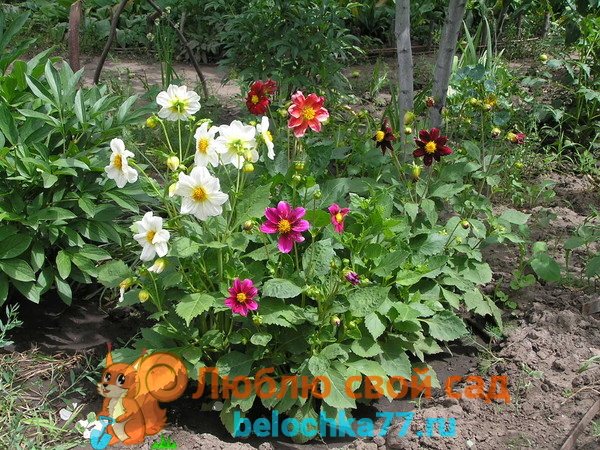

At the end of May, there comes a period when most of the seedlings from the windowsill move to the dacha. Dahlias will not be an exception, but first they must be hardened. This is a gradual accustoming of seedlings to external weather conditions.
Some gardeners practice the method of hardening in the refrigerator, but this option will not be optimal if there are a lot of seedlings. It can be used when flowers are grown in single copies to decorate balconies and loggias.
For gardeners, it is best to carry out these activities directly at the dacha, where it is possible to shelter the flower from the wind with a wall of the house or a tall plant. If in the fall it was not possible to prepare beds for dahlias, then this can be done while the seedlings are waiting for their turn for planting.
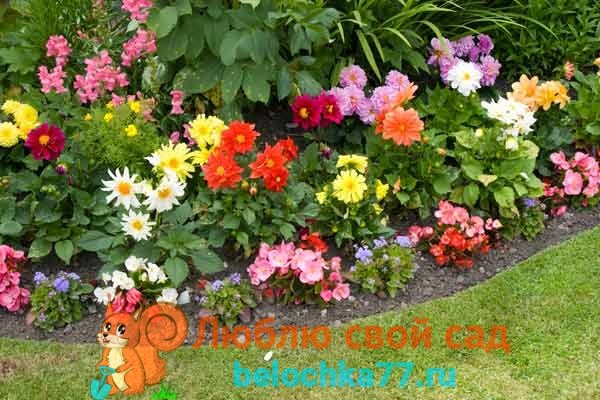

The soil is dug up with the introduction of humus and mineral fertilizers. Fresh manure can only be applied during autumn tillage. Excess nitrogen will cause active development of stems and shoots, and flowering will be postponed for a long time.
Planting flowers is carried out in an open, sunny place, but it must be protected from winds and drafts. Dahlia loves warmth and light and thanks for this with a lush and long flowering.
High varieties should be supported when planting so that the stems do not fall to the ground under the weight of the flowers. Install it simultaneously with planting a flower.This measure excludes damage to the root system. There should be about 70 cm between the plants.
The distance between flowers of medium height is 50 cm, and 30 cm will be enough for dwarf dahlias.
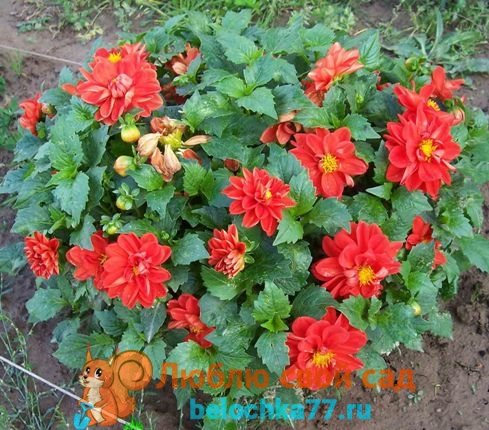

The first feeding is carried out two weeks after the flower transplant. It should include potassium and phosphorus. First, the plant is watered with clean water, and then with a fertilizer solution. This will prevent the dahlia roots from being burnt.
- To maintain the beauty of the bush, wilted inflorescences are removed, but if the summer resident plans to get his seeds, then several inflorescences should be left.
- Watering as the soil dries up, fertilizing with mineral fertilizers and keeping the root area clean will not give the gardener a lot of trouble.
- Pollination of the soil around the stems with wood ash simultaneously serves as a fertilizer and protection against diseases and pests.
Bacopa - growing from seed
How to keep the flowering of the bush longer
To prolong the flowering of dahlias, they do a very simple thing. It is necessary to remove faded flower baskets. When there are many of them, they take on a lot of food. If this is not done, flowering ends quickly, because the plant's main goal is to leave behind offspring, seeds. By removing the faded flowers, new buds are tied and flowering continues.
- The last feeding with nitrogen fertilizers is carried out in June, if you feed with nitrogen later, the plant heals, and only greens will grow;
- If a faded flower is not removed on a branch, then new buds will not be tied next to it;
- Try not to pick off the faded flowers with your hands, but cut off with a pruner just above the bud that is formed. This will make the bush look prettier and tidier and will not damage other buds that are very close.
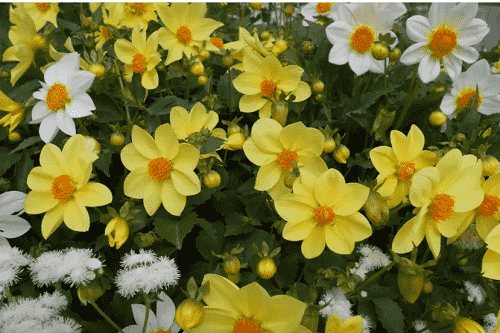

Self-collection of dahlia seeds and their selection for sowing
Abundant fruiting is one of the reasons why annual dahlias are considered easy to grow and “budget” plants, an excellent alternative to perennial crops. After the end of flowering, the achenes of the fruits ripen, from which, after drying, you can get a generous harvest of seeds. And although they will give offspring with a wide range of characteristics and will not allow exactly to preserve the characteristics of the mother plant, nevertheless, self-collection of seeds is very popular.
On average, it is possible to collect seeds from the bushes within a month after the baskets have flowered, cutting off the hemicarps whole. Dahlia baskets are dried in a ventilated and dry place at normal room temperatures. Seeds can be removed only after the seed is completely dry.
You can also store dahlia seeds at room temperatures. Heat and high humidity, like light, are indicators from which they should be protected. Dahlia seeds keep well in simple paper bags.
When buying dahlia seeds in a store, you should pay attention to three parameters:
- On the doubleness of the inflorescences.
- Color nuances.
- To the height of the plants (the higher the variety, the longer the growing season and the more limited the possibilities of its use in decorating the garden).
Dahlias can hardly be called elite plants, their seeds are available and found everywhere. When choosing quality seeds, it is enough to show the usual care. If you are buying rare varieties and mixtures of varieties or new varieties, then it is better to choose producers that have proven themselves well with other new plants. When choosing seeds, pay special attention to the recommended uses, especially if you want to grow dahlias in curbs or containers rather than in flower beds.
Transfer to a permanent place
Seedlings of dahlias from seeds are planted outside when the night frosts are over. In the Central region, this is the end of May - beginning of June. Before moving to a permanent place, the seedlings are tempered, gradually accustoming them to environmental conditions.
Plants are taken outside in the shade, first for a few minutes a day, then this time is increased and periodically exposed to the sun. Ideally, before planting, the seedlings should tolerate a round-the-clock stay in the open air without deterioration.
Seat selection
The sunniest, windless places are chosen for landing. In the shade, flowering will be weak. But with diffuse shading, the dahlia, although it blooms less abundantly, it grows good tubers. This should be taken into account if it is planned to save the planting material in the future.
Most of all, dahlias are afraid of stagnant water. They are planted in completely dry areas. If necessary, raise the flower bed by 10-15 centimeters or make a slope to drain the water. At the bottom of the planting pit, stones, broken brick or expanded clay can be laid as drainage.
This culture is not demanding on the nutritional value of the soil. Since autumn, when preparing a flower bed, it is allowed to demolish manure, mineral fertilizers and, if necessary, lime for deoxidation. But in the spring, do not overuse organic and nitrogen fertilizers.
Landing
When drawing up a planting scheme, the height of the dahlia is taken into account. The taller the plant, the more free space it needs:
- Tall varieties are planted at a distance of 70 centimeters from each other;
- Medium height - 50 centimeters;
- Stunted ones need 20-30 centimeters.
To less traumatize the roots, the cups are spilled abundantly the day before the transplant. Ash can be added to the planting hole. That's all the dahlia planting tricks.
Storage
Preparation for storage begins in early autumn, mulching the root collar with compost or peat to avoid damage from the first frosts. Plants are dug up when they darken and wilt. The weather should be dry and clear. The stems are cut, leaving a height of 10 cm, the tubers are removed, the earth is shaken off. It is not recommended to forcefully pull the plants by the stems, otherwise it is not difficult to damage the root collar. Root tubers are dried for 10 days in a cool room, after which they are lowered into the basement.
Planting material is stored in a plastic or wooden container, on the bottom of which paper is laid, sawdust or dry sand is poured on top. The storage temperature should be between 6-8 ° C. Storage in the apartment is also allowed if there is a sufficiently cool place.
Low-growing dahlias - description of plants
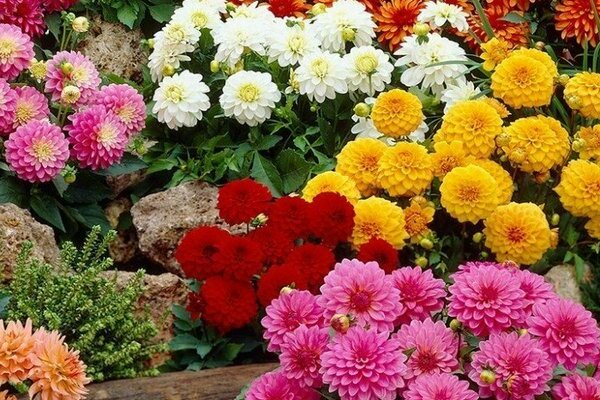

The stem of this culture does not exceed 30 cm, flowers vary in diameter from 3 to 25 cm, while tall varieties of dahlias can reach more than 150 cm in height.
The size of the flower is very large. They are both terry and semi-double. And simple, with expanded, twisted leaves and a wide variety of inflorescences. There is also no uniformity in colors. Shades of flowers are orange, pink, red, yellow, purple and even black. There are flowers that are not painted in one color, but in two or more colors. Low-growing dahlias are very fond of growing recently by gardeners.
Dahlia characteristic
This flower is a perennial that is dormant for a long time. After flowering, only the tubers are preserved, which contain nutrients. All parts of the plant necessary for flowering in the next season are laid here. The part of the flower that is above the ground dies off.
The base of the flower is made up of nodules or root cones. In addition to nutrients, the necessary moisture for the plant is also stored here. With this pantry, plants tolerate winter and dormancy well. And in the spring they begin to actively grow and develop again.
At the bottom of the stem is the so-called root collar, to which root tubers are attached. This root collar must be protected and never cut off. Since new shoots will grow from it at the beginning of a new vegetative period. If the root collar is damaged, then the roots will also die.
Next are the stems of the flower.Inside they are empty, however, the stem is strong enough. It is necessary to tie only those plants that have a long stem. Since with abundant flowering with large large inflorescences, the stem can break from severity.
The last part of the flower is the inflorescences, which are a complex basket of various flowers with a wide variety of shades. Flowers are usually tubular, marginal and ligulate.
In turn, the marginal flowers are further divided into those that are flat and those that are wrapped in one direction or another. Also modified collar. Tubular flowers are divided into open flowers and eternal buds.
Vegetative period
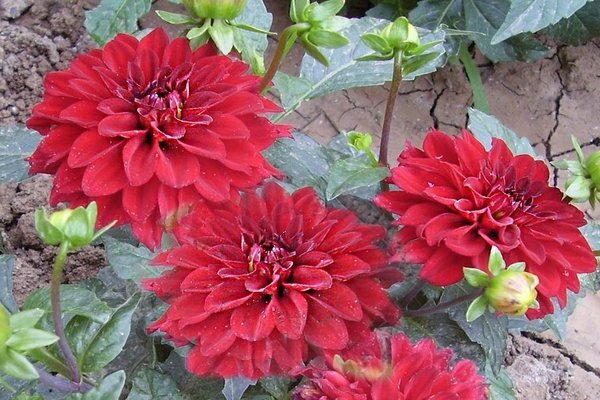

Dahlias have a very long dormant period. Therefore, after one vegetative period has ended, the stem is cut off, and the root tubers with a root collar are placed in a pot and taken to a room that will be protected from sunlight for the whole winter. And where the temperature will not be higher and not lower than + 5 ... + 8 degrees.
In this position, the root tubers rest for several months. If this rule is not observed and the root tubers are placed at home on the window, and also continue to care for the flower, then the plant will die.
After the root cones have woken up from a dormant period, a new vegetative period will begin. At this point, the plants are transferred to a bright room with a higher temperature and begin to actively water.
When the weather is already warm on the street and the soil warms up enough, the dahlias are planted on a site, where they will then grow throughout the rest of the season until the onset of new frosts. Then everything is repeated in a circle.
This plant is propagated using cuttings. Also undersized species can be propagated by seed.
When growing flowers by seed, the seeds germinate first. And with cuttings propagation, cuttings take root, and then root nodules are formed. Therefore, for the winter, plants can also be transplanted and carried away to a dark, warm place.
Low-growing, or dwarf, dahlias: characteristics
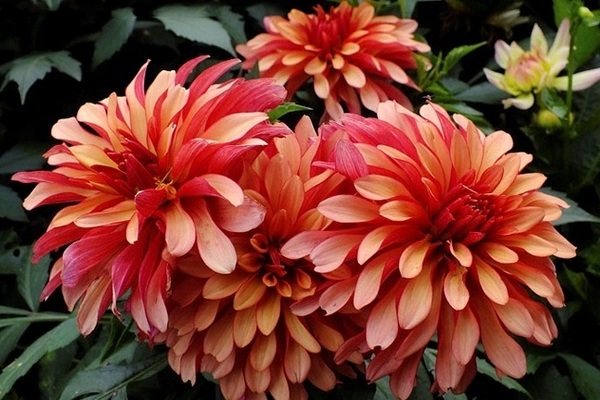

Dahlias undersized Gallery Art Deco: Photo of the variety
Dwarf or dwarf dahlias are called dahlias with a short stem. They are also called midgets or minions. These varieties have won the love of gardeners relatively recently. When breeders bred varieties with very beautiful inflorescences of various colors.
In addition, dwarf plants have a high immunity to various common diseases, and are unpretentious in care. And also suitable for growing on a windowsill or loggia. In addition, the smaller the stalk of the dahlia, the faster the time of its flowering.
Often, such plants that have a low stem are also called curbs. Because it is believed that they can be grown in flower beds. This is not entirely true, since real curb dahlias have a stem of more than 60 cm, while undersized dahlias grow no more than 30 cm.
In addition, the growth of the stem is also influenced by the soil conditions on which the plant grows. Some plants can grow up to 30 cm tall, while others can grow up to half a meter. This is also influenced by the fertility of the soil, its composition, and the level of moisture. As well as the amount of dressings and the surrounding ecology in general.
The more comfortable the plant will grow and develop, the higher its stem will be. This will not affect the quantity and quality of flowering, since tall plants with large leaves often have small flowers.
It is noted that flowers with short stems require less moisture.
Dahlias "Funny guys"
I would especially like to highlight the dwarf variety "Merry Guys", which is very popular among gardeners. It is a perennial but is grown as annual dahlias. As a rule, this is a mix of colors that look very impressive on flower beds and flower beds. Plant height up to 60 cm, semi-double and simple inflorescences of various juicy shades, up to 10 cm in diameter.They are used in monocultural flower beds, mixborders, on ridges, for landscaping balconies.
The variety is grown through seedlings or seeds as well as other annual dahlias. They bloom 2-3 months after sowing and bloom profusely until frost. You can dig root tubers before freezing, save them like ordinary perennial dahlias and plant them again next year.
Benefits of Miniature Varieties
Interest in short dahlias is associated with their botanical and decorative characteristics.
- Unlike tall groups, they do not require so much light and space, they are suitable for small gardens.
- The undoubted advantage is abundant (even leaves are not visible) and long flowering. When growing tubers, they bloom in June and last until frost.
- They are easier to care for - they do not need to be tied up, shaped by pinching, pinching, pinching.
- The plant itself is strong, with thick strong peduncles that do not break from wind and rain, practically does not get sick and is not damaged by pests.
- Low-growing dahlias have wider decorative possibilities. They are used as border flowers, as a container culture - to decorate terraces, patios, balconies, they look great in carpet flower beds.
- For smaller tubers, it is easier to find storage space.
Preparing for landing
Dwarf dahlias love fertile, neutral soil. To prepare a site for planting, in the fall, the earth is mixed with heated sand, humus or peat is added in equal proportions. Before sowing, the soil is treated with a solution of potassium permanganate to disinfect and protect against diseases.
For dahlias, a spacious area is needed, since even dwarf varieties grow very quickly and densely. The distance between the bushes should be large enough. It is better if the planting site is sunny and warm, closed from drafts. It is not recommended to plant these plants under any structures and trees, they need light, especially in the morning. Lack of light will immediately affect the quality of flowering. The stems will reach for the light, become fragile, thin. It has been noticed that dahlias grow excellently on the southern gentle slopes.
You may be interested in: Dahlias funny guys: description and photo of the flower
Which variety should you choose?
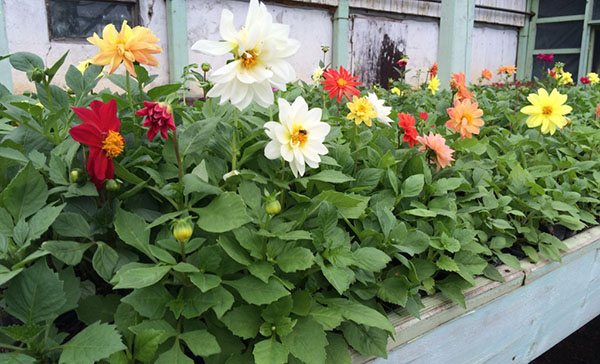

Before planting, you should familiarize yourself with the varieties of annual dahlias with photos and names. Some of them will not grow more than 20-20 cm (undersized), so they are not suitable for decorating bouquets. Tall varieties can grow up to 70-90 cm in height and can form a veritable hedge. Among the most popular varieties of annual dahlias are:
- Figaro is a low bush (up to 45 cm), on which lush multi-colored inflorescences are formed;
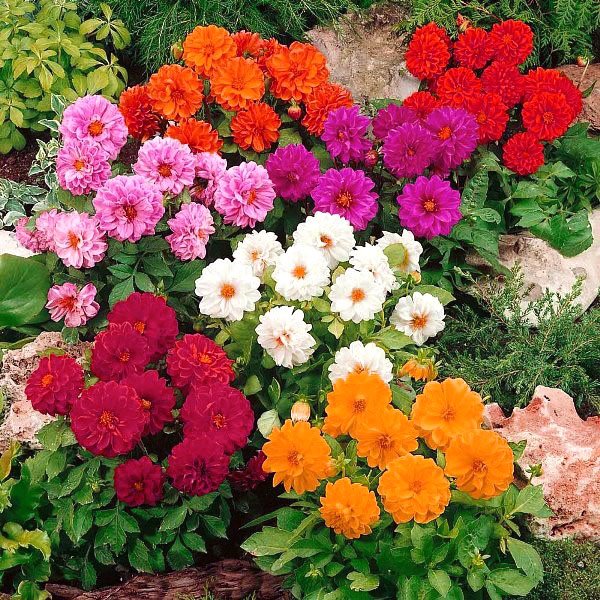

- Piccolo is another undersized bush (up to 40-45 cm), on the flowers of which the core and petals are clearly distinguished;
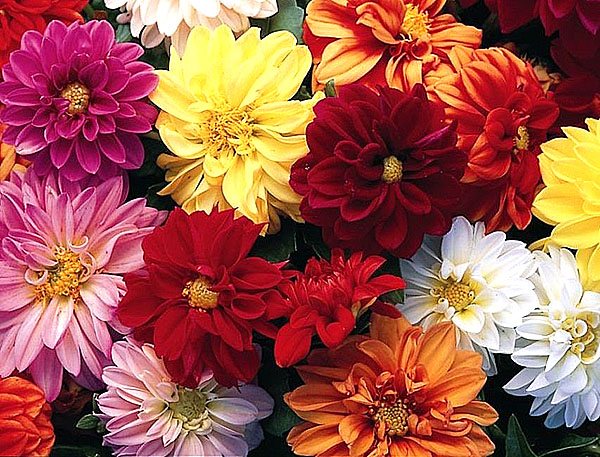

- Unvins Dwarf is a taller plant, can reach 60 cm.
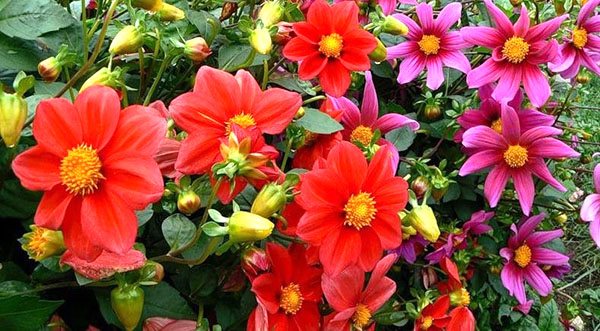

Growing annual dahlias is an easy way to get vibrant flowers with little investment or preparation. Tall plants make beautiful bouquets or hedges, and low-growing annual dahlias form small borders. They are easy to care for, do not require winter preparation and fertilization. In addition, the seeds of the plant can be collected by yourself and left for planting next season.
Dahlia breeding
Carried out by cuttings or dividing tubers.
Cuttings
Parts of the branches with a heel are cut off, the cut is treated with a biostimulator. In winter, they are left in the cold so that they do not germinate. When planted in summer, they are rooted in boxes.
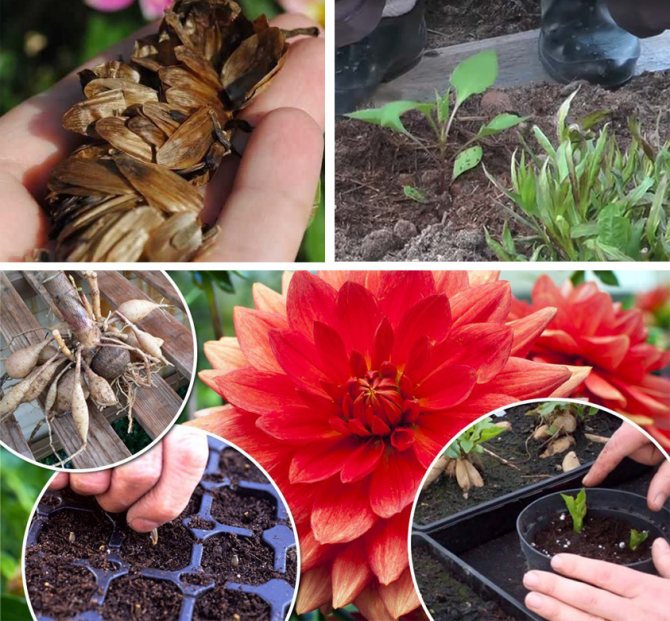

The shoots are placed at an angle to the surface of the earth, moisten the soil and cover with a film or covering material. After the appearance of a good root coma, the germinated plants are transplanted into the ground.
Division of rhizomes
It is done in the fall, after the plant has been dug up.The healthiest tubers are selected, separated from each other and stored. The next breeding stage takes place in the spring. It is described above.
Annual dahlias are one of the most popular garden flowers. Plants decorate flower beds before the onset of cold weather. When growing dahlias, special attention is paid to the choice of varieties, proper planting and care during the growing season.
Landing rules
Experienced summer residents know that only those dahlias that were grown in seedlings will begin to bloom in June-July. If you plan to grow annual dahlias from seeds, you will have to figure out when you can plant flowers on the street. Experts recommend doing this not earlier than the last days of May.
The best way is to figure out how to plant annual dahlias for seedlings. Seeds are sown in containers or special seed boxes. After sending the seed into the soil, you need to cover the containers with earth with a film to make a mini-greenhouse. The optimum temperature for germination is considered to be 25-27 ° C.
When to sow annual dahlias for seedlings? This must be done in early April. But if flower growers want to get tubers from annual flowers, then experts recommend planting seeds for seedlings of annual dahlias in early March. When planted early, the flower will have time to form a tuber. It can be dug up and planted next spring.
Having figured out when to plant one-year-old dahlias on seedlings, they start choosing a soil mixture. A soil made of sand, peat and perlite is best suited for flowers.
The containers in which the summer resident plans to sow an annual dahlia for seedlings must be thoroughly washed and disinfected. They can become the source of some diseases. Pests sometimes remain in the walls of clay pots. There should be drainage holes at the bottom of the prepared seedling boxes.
Having decided when to plant annual dahlias for seedlings, pre-soak the seeds overnight. It is best to use warm water diluted with aloe juice in a 2: 1 ratio. This procedure accelerates the sprouting of the sprouts. To disinfect the seeds, you need to soak them for a short time in a dark solution of potassium permanganate.
How to plant annual dahlias? The seeds are laid out on the ground at a distance of 3 cm from each other, covered with a 1 cm layer of earth and watered with water. The container is covered with glass (film) and placed in a warm, bright place.
Annual dahlias - name and description of the variety with a photo of flowers
There are a lot of varieties of dahlias, they differ among themselves in height, type of bud, flowering time.
- In height, dahlias are tall, stunted and dwarf;
- In terms of flowering time, tall varieties bloom several weeks later than undersized or dwarf varieties;
- Each variety differs from each other in flower shape, size, color, as well as leaves.
In these photos you can see what different varieties of annual dahlias look like.
- simple,
- peony,
- anemic,
- collar,
- spherical,
- nymph,
- pompom,
- chrysanthemum,
- cactus.
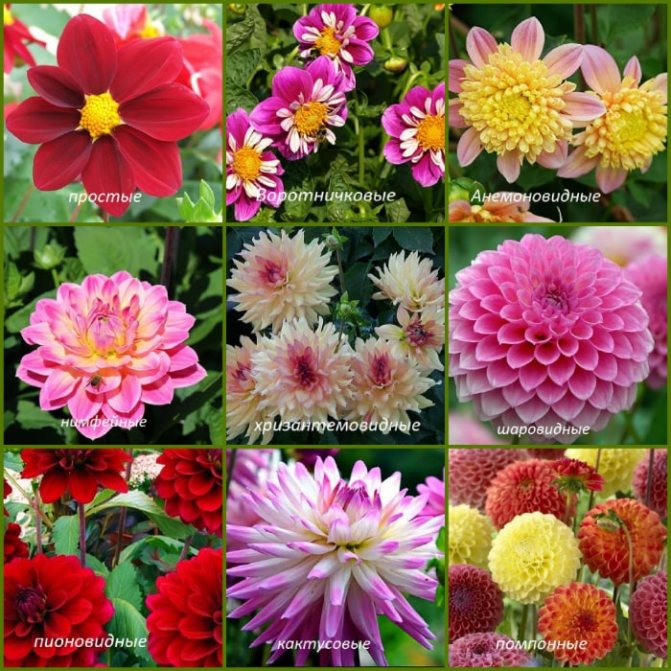

Pests and diseases
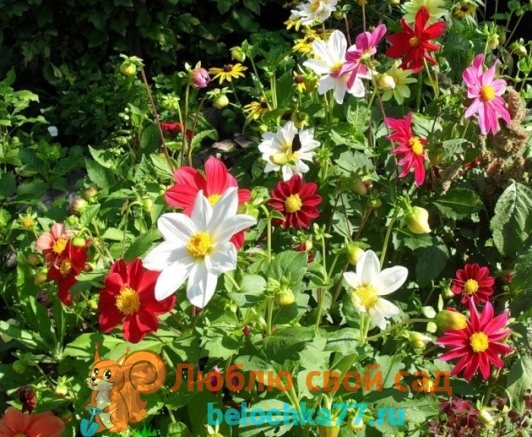

By observing the necessary requirements for growing seedlings and cultivating the soil, it is possible to avoid damage to plants by many diseases, but if this does happen, then it is better to know the enemy by sight.
Leaf spot most often occurs when the planting is too dense and there is no air circulation in the area with dahlias. It is expressed in the appearance of yellow-green spots, which grow over time and become gray-brown, with prominent dark edges.
If the disease was noticed on time, then the affected leaves are cut off and burned, and the plant itself is treated with fungicides. "Fundazol" or "Oxyhom" will be appropriate. If the disease is started, the dahlia bush is completely destroyed, and the neighboring plants are protected with the same chemicals.
White rot is characterized by discoloration of the base of the stems and their thinning. The fungus infects the plant at the initial stage of the growing season, and also affects the young shoots of an adult dahlia. The cause of rot is the excessive deepening of the seedling during planting.
For the treatment of brown rot, drugs are used: "Fundazol", "Gamair", "Fitosporin". Fusarium wilting. The disease affects the tubers or the root system of the dahlia, which leads to wilting of the tops of the shoots, buds and leaves. A pinkish bloom appears on these parts of the plant.
Similar signs are characteristic of verticillary wilting, only the plaque will be brownish in color.
The cause of the lesion is thickened planting, poor ventilation of plants, waterlogging of the site.
Prevention consists in adhering to the rules of agricultural technology, and fungicides are applicable for treatment: Oxyhom and Fundazol.
Dahlias are also attacked by flying and crawling insects. The succulent leaves of the flower become a favorite treat for caterpillars, which appear due to the "work" of the whitefly, whitefly and other pests.
Caterpillars eat foliage and young shoots, worse when they bite into the base of the stem. The plant begins to lag behind in development, and a severe defeat leads to its death.
With an insignificant amount of the pest, it is harvested by hand, and with a massive appearance, insecticides should be used. In this case, both the larval clutches and the insects themselves will be destroyed.
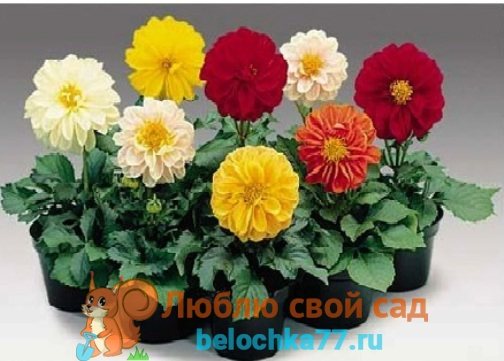

Aphids are a very small pest that settles on the lower part of the leaf and sucks the juice out of it. The deformation of the sheet plate occurs, it twists and turns yellow.
If a plant louse is seen on the flower, these parts of the plant should be cut and burned along with the insects. Additionally, treatment is carried out with chemicals: "Confidor", "Fitoverm" and other insecticides against aphids. It is necessary to carry out prevention of neighboring plants in order to also exclude the possibility of their damage.
For the appearance of slugs, conditions of high humidity become a favorable environment. The activity of the pest occurs at night, when they destroy the leaf apparatus.
Regular inspection of the plant and manual collection of insects, in small numbers, will protect the flower from death. Preventive measures - processing the soil around the plants with ground pepper, ash - will prevent their appearance. And the "Thunderstorm" drug will destroy the pest when other measures are ineffective.
Annual dahlias - how to choose the right variety?
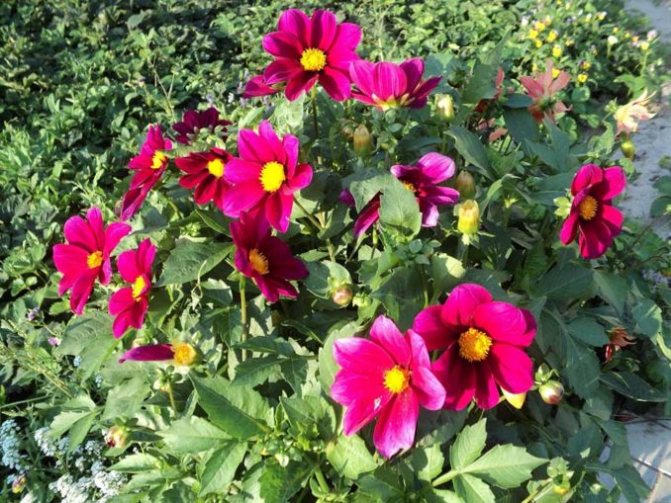

First of all, you need to decide on the type of flower. Today, more than 50 types of dahlias are known, each of which differs in height, flowering period and color. Many people prefer varietal mixtures, which allows them to end up with low-growing flowers of various shades. This beauty will certainly please you and will decorate your summer cottage. As for the acquisition of planting material, it is necessary to give preference to specialized stores.
The plant grows best on loose, neutral and non-acidic soils. Particular attention should be paid to fertilizers, which are applied a couple of times a year: in spring and autumn. When can you sow dahlias? Experts advise growing seedlings from seeds. In this case, it can be planted in early April, and the flowers will bloom in early summer. If you decide to immediately sow seeds in the ground, then keep in mind that the most suitable time for this is the end of May, but flowering will be in mid-August.
Perennial dahlias
The names of perennial varieties are repeated by annuals, they are distinguished by inflorescences, and not by the growing period. And also by breeding methods. Perennials are planted with tubers. Dahlias are classified according to their flower shape into the following types:
Simple
They have petals in one row, low with a yellow core, only 0.6 m with straight, branched branches.Varieties: Princess Mary, Yellow Hummer, Orange, Cupid, Kolleret.
Anemone
Double and semi-double flowers, ligulate petals, tubular in the center. Tall perennial over 100 cm. Looks great in a mixborder.
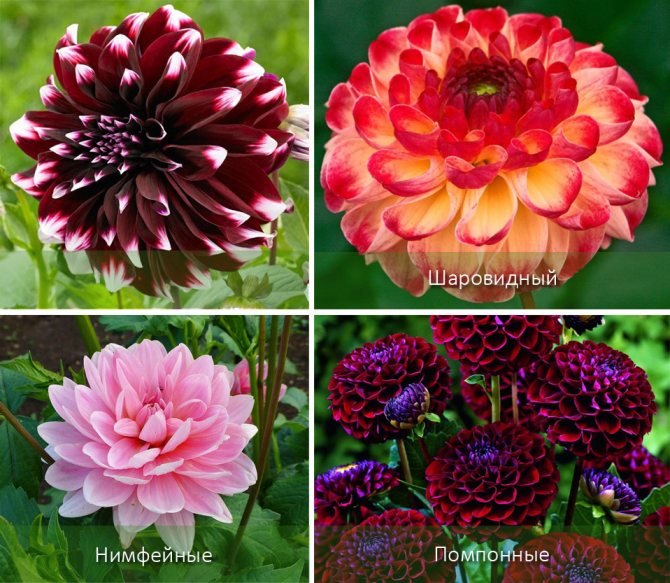

Has varieties: Inka, Mambo, Polka. Comet, Lambada.
Peony
Large semi-double or double, resemble peonies. High. En Rouge, Red Tunic, Bendall, Beauty Chic, Opera.
Collar
Large baskets, 10 cm wide, On top of the flat extreme petals lie narrow white ones that resemble a collar. Tall varieties 120 cm. They bloom from mid-summer to the first frost. Popular types loved by flower growers: Mona Lisa, Knight, Granato, Butterfly, Heart of Danko.
Spherical
Multiple petals of various colors, more than 9 cm, with wide obtuse extreme petals. Tall branched bushes, used for cutting. The varieties are varied, the best are Kenora Fairball, White Astaire, Gypsy Knight, La Bayadere.
Pompom
They got their name from the small flowers that resemble small pom-poms. Terry, 5 cm with extreme obtuse petals, tubular, folded in the form of tiles.
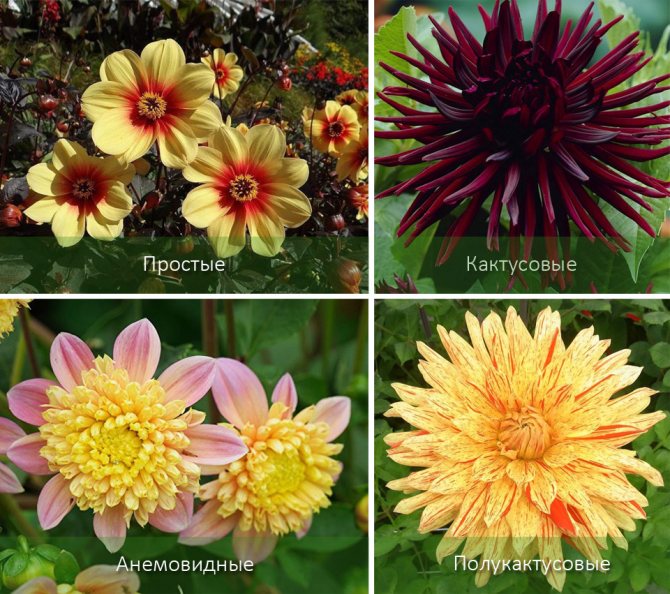

Painted in different colors except blue. Bushes are dense, with strong branches. Bred species: Viking, Little William Rocco, Amber Queen.
Cactus
A shrub plant with up to 15 peduncles. The flowers are dense, with a diameter of 10 cm, pointed petals in the form of needles. It is used for growing in a group or in a single way. Black Wizard, Favorite, Princess Park, Blackbury look amazing.
Semi-cactus
Transitional group of medium aster. Rises to a height of 130 cm, lush foliage. The inflorescences are double, large, partially tubular, pointed flowers. The best varieties: Meteor, Island Delight, Pipes Pink, Just Peachy,
Nymphae
Huge bushes, branched. Leaves cut into several parts. Flower 18 cm, resembles a water lily, consists of petals inclined towards the center. Tuberous roots. Famous and popular types: Twinney, Kens Flame, Rapallo.
Decorative
The largest class of dahlias with double flowers. Leaves are opposite. Bloom from July to September. The flowers bend over to the stem for a stunning effect.
Planting tubers in open ground
In temperate latitudes, dahlias are not left inside the earth. For annual flowering, rhizomes are dug in the fall, proper storage is carried out in the winter months, and then planted in the spring. This can also be done in two ways. For an earlier appearance of buds, root tubers are planted in large pots for germination, then placed in the ground. Or, immediately after the end of the threat of frost, they are planted in the garden.
This breeding method has advantages. All the characteristics of the mother plant are preserved in the roots.
Preparing tubers for planting
Tubers are germinated in a greenhouse or at home on a windowsill, in prepared containers with soil treated as for seedlings. Before planting, the roots are examined, the dried ones are removed. They are planted without deepening, left above the surface of 3 cm, preferably with kidneys. When they begin to sprout, they are taken out of the ground, shaken off and divided with a knife, leaving one young bud on each part. The sections are treated with a biostimulant.
How to care for flowers
Dwarf dahlias, like other types of garden plants, require regular feeding. For 10 liters of water, 15 g of fertilizers are taken (Kemira Universal works well) and the solution is poured under the root of the plant. This procedure is performed in June. Slurry is applied 2-3 times in the first 2 summer months. In early August, the bushes are fed with phosphorus-potassium supplements, which accelerates the ripening of the roots. Care also consists in constant loosening and weeding, carried out at least 4 times per season.
Dahlia life cycle
A new growing season begins in dahlias only when the previous one is completely completed.Even if you transplant a flower into a pot, transfer it to heat, water and feed, the plant will still die. It is necessary to cut off the stems as soon as the first frosts hit. Root tubers are dug up and taken to a dark storage place. At a temperature of about 7 degrees, they can rest for several months.
As soon as the root cones awaken, the growing season begins. They need to be brought into a warm room, moistened and exposed to light. Dahlias are planted in the ground when the weather is right. After frost, the root tubers are removed from the soil, the cycle begins anew.
Dahlia can be propagated by seeds or seedlings. The rest of the plant behaves in the same way as others. Seeds germinate, roots are formed, then root tubers are laid.

